Paul van Yperen's Blog, page 420
May 5, 2014
Paul Azaïs
French film actor Paul Azaïs (1903-1974) appeared in 112 films between 1929 and 1966. As the nice guy who is always there for a helping hand or a good laugh, he appeared in several films by Max Ophüls and Raymond Bernard or supported comedy stars like Fernandel and Louis de Funès.
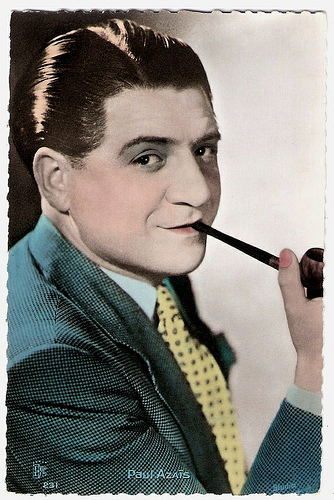
French postcard by EPC, no. 231. Photo: Studio.
The most powerful anti-war film ever made
Paul François Robert Azaïs was born in Paris, France in 1903.
He began his career as an extra at the Chatelet theatre before getting small roles in operettas and music hall shows.
Thanks to his stage experience, he was offered a small role in the first all-talking feature, Les Trois Masques/The Three Masks (André Hugon, 1929). Les Trois Masques was filmed in England because none of the French film studios had yet been wired for sound.
In 1932, he played a small part in the French crime film Fantômas (Pál Fejös, 1932) starring Jean Galland as the popular pulp character Fantômas, a super criminal. It was loosely based on the original Fantômas novel by Marcel Allain and Pierre Souvestre.
Azaïs had a bigger role in the box office hit Les Gaietés de l'escadron/Fun in the Barracks (Maurice Tourneur, 1932), a French comedy starring Raimu , Jean Gabin and Fernandel .
Perhaps his most interesting film was Les Croix de Bois/Wooden Crosses (Raymond Bernard, 1932). Hal Erickson at AllMovie : “Les Croix de Bois may well be the most powerful anti-war film ever made; certainly it is the grimmest and most uncompromising. Starting with an impressionistic shot of a gloomy hillside studded with white grave markings, the film delineates the hopelessness and horror of war in such explicit terms that at times it's nearly impossible to watch.”
Among Azaïs’ other films were Raymond Bernard's Les Misérables (1933), Pension Mimosas (Jacques Feyder, 1935) starring Françoise Rosay , and Divine (Max Ophüls, 1935). The most notable thing about Divine is that it is the only film for which the celebrated writer Colette supplied an original screenplay.
Azaïs often played the good guy in his films, always ready for support, a good laugh or a helping hand. He was a devoted ‘knight’ to Annabella in Anne-Marie (Raymond Bernard, 1936)) and to Edwige Feuillère in Sans lendemain/Without Tomorrow (Max Ophüls, 1939).
Also interesting is the French drama Tempête sur l'Asie/Storm over Asia (Richard Oswald, 1938), starring Conrad Veidt . Director Oswald had left Austria as it became an increasingly hostile working environment in the years leading up to the Anchluss. It was Oswald’s last film in Europe, before he moved to the United States and made three films in Hollywood. Conrad Veidt was similarly an exile from Germany, and had settled in Britain.
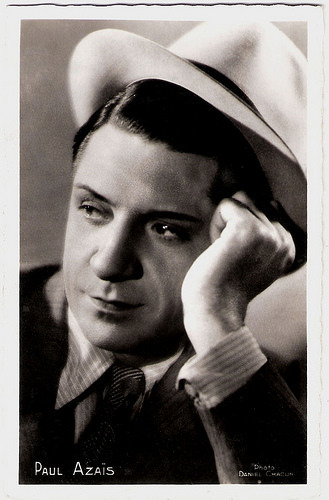
French postcard by EPC. Photo: Daniel Chacun.
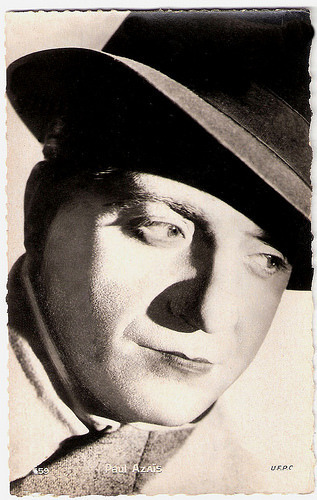
French postcard by Editions Chantal, Rueil, no. 559. Photo: U.F.P.C.
The wheel turns
Paul Azaïs career reached its top during the first years of the French occupation by the Germans.
He played in some of the best comedies of the era, produced by the Nazi-run Continental studio, such as Narcisse (Ayres d'Aguiar, 1939) with Rellys , Ne le criez pas sur les toits/Do not shout it from the rooftops (Jacques Daniel-Norman, 1943) and the entertaining farce Adrien (Fernandel, 1943), the latter two both starring Fernandel .
Unfortunately, Azaïs had a bicycle accident in 1943 which caused him a skull fracture and had him in a coma for 20 days. After recovering, he suffered severe memory problems, but Azaïs eventually started to work again although in minor parts.
After the war, Azaïs continued to play supporting parts in French films like the dramas Au grand balcon (Henri Decoin, 1949) with Pierre Fresnay , and Retour à la vie/Return to Life (Georges Lampin, André Cayatte, Henri-Georges Clouzot and Jean Dréville, 1949).
He had small roles in such classics as the Guy de Maupassant adaptation Le Plaisir/House of Pleasure (Max Ophüls, 1951) and Casque d'or/Golden Marie (Jacques Becker, 1952) featuring the young Simone Signoret .
Azaïs played the lead in the crime comedy Le Roi du bla bla bla/The King of the Bla Bla Bla (Maurice Labro, 1951) starring Azaïs and Louis de Funès as the gangsters Bébert and Gino.
He reunited with Louis de Funès in Tourments/Agonies (Jacques Daniel-Norman, 1954) but now as a security guard (Azaïs) and a private detective (De Funès). Azaïs had a small part in another film featuring De Funès, the French comedy drama L'impossible Monsieur Pipelet/The Impossible Mr. Pipelet (André Hunebelle, 1955), also starring Michel Simon .
Aware of the precariousness of the entertainment business, he founded in May 1957 the association La Roue rourne (The wheel turns), which assisted needy actors. He invested in this cause until the end of his days.
Paul Azaïs died in 1974 in Paris, aged 71. During his life he was honoured as Chevalier de l’Ordre international du Bien Public, and received both the Grand Prix Humanitaire de France, and the Médaille d’Or du Mérite National.
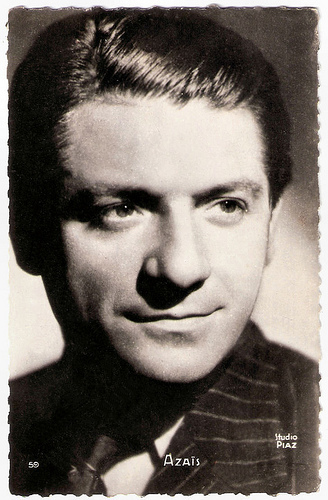
French postcard by Editions P.I., Paris, no. 59. Photo: Studio Piaz.
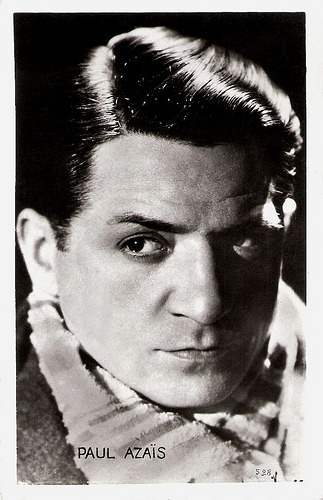
French postcard, no. 528.
Sources: Hal Erickson (AllMovie), James Travers (Films de France), Wikipedia (French and English) and .

French postcard by EPC, no. 231. Photo: Studio.
The most powerful anti-war film ever made
Paul François Robert Azaïs was born in Paris, France in 1903.
He began his career as an extra at the Chatelet theatre before getting small roles in operettas and music hall shows.
Thanks to his stage experience, he was offered a small role in the first all-talking feature, Les Trois Masques/The Three Masks (André Hugon, 1929). Les Trois Masques was filmed in England because none of the French film studios had yet been wired for sound.
In 1932, he played a small part in the French crime film Fantômas (Pál Fejös, 1932) starring Jean Galland as the popular pulp character Fantômas, a super criminal. It was loosely based on the original Fantômas novel by Marcel Allain and Pierre Souvestre.
Azaïs had a bigger role in the box office hit Les Gaietés de l'escadron/Fun in the Barracks (Maurice Tourneur, 1932), a French comedy starring Raimu , Jean Gabin and Fernandel .
Perhaps his most interesting film was Les Croix de Bois/Wooden Crosses (Raymond Bernard, 1932). Hal Erickson at AllMovie : “Les Croix de Bois may well be the most powerful anti-war film ever made; certainly it is the grimmest and most uncompromising. Starting with an impressionistic shot of a gloomy hillside studded with white grave markings, the film delineates the hopelessness and horror of war in such explicit terms that at times it's nearly impossible to watch.”
Among Azaïs’ other films were Raymond Bernard's Les Misérables (1933), Pension Mimosas (Jacques Feyder, 1935) starring Françoise Rosay , and Divine (Max Ophüls, 1935). The most notable thing about Divine is that it is the only film for which the celebrated writer Colette supplied an original screenplay.
Azaïs often played the good guy in his films, always ready for support, a good laugh or a helping hand. He was a devoted ‘knight’ to Annabella in Anne-Marie (Raymond Bernard, 1936)) and to Edwige Feuillère in Sans lendemain/Without Tomorrow (Max Ophüls, 1939).
Also interesting is the French drama Tempête sur l'Asie/Storm over Asia (Richard Oswald, 1938), starring Conrad Veidt . Director Oswald had left Austria as it became an increasingly hostile working environment in the years leading up to the Anchluss. It was Oswald’s last film in Europe, before he moved to the United States and made three films in Hollywood. Conrad Veidt was similarly an exile from Germany, and had settled in Britain.

French postcard by EPC. Photo: Daniel Chacun.

French postcard by Editions Chantal, Rueil, no. 559. Photo: U.F.P.C.
The wheel turns
Paul Azaïs career reached its top during the first years of the French occupation by the Germans.
He played in some of the best comedies of the era, produced by the Nazi-run Continental studio, such as Narcisse (Ayres d'Aguiar, 1939) with Rellys , Ne le criez pas sur les toits/Do not shout it from the rooftops (Jacques Daniel-Norman, 1943) and the entertaining farce Adrien (Fernandel, 1943), the latter two both starring Fernandel .
Unfortunately, Azaïs had a bicycle accident in 1943 which caused him a skull fracture and had him in a coma for 20 days. After recovering, he suffered severe memory problems, but Azaïs eventually started to work again although in minor parts.
After the war, Azaïs continued to play supporting parts in French films like the dramas Au grand balcon (Henri Decoin, 1949) with Pierre Fresnay , and Retour à la vie/Return to Life (Georges Lampin, André Cayatte, Henri-Georges Clouzot and Jean Dréville, 1949).
He had small roles in such classics as the Guy de Maupassant adaptation Le Plaisir/House of Pleasure (Max Ophüls, 1951) and Casque d'or/Golden Marie (Jacques Becker, 1952) featuring the young Simone Signoret .
Azaïs played the lead in the crime comedy Le Roi du bla bla bla/The King of the Bla Bla Bla (Maurice Labro, 1951) starring Azaïs and Louis de Funès as the gangsters Bébert and Gino.
He reunited with Louis de Funès in Tourments/Agonies (Jacques Daniel-Norman, 1954) but now as a security guard (Azaïs) and a private detective (De Funès). Azaïs had a small part in another film featuring De Funès, the French comedy drama L'impossible Monsieur Pipelet/The Impossible Mr. Pipelet (André Hunebelle, 1955), also starring Michel Simon .
Aware of the precariousness of the entertainment business, he founded in May 1957 the association La Roue rourne (The wheel turns), which assisted needy actors. He invested in this cause until the end of his days.
Paul Azaïs died in 1974 in Paris, aged 71. During his life he was honoured as Chevalier de l’Ordre international du Bien Public, and received both the Grand Prix Humanitaire de France, and the Médaille d’Or du Mérite National.

French postcard by Editions P.I., Paris, no. 59. Photo: Studio Piaz.

French postcard, no. 528.
Sources: Hal Erickson (AllMovie), James Travers (Films de France), Wikipedia (French and English) and .
Published on May 05, 2014 23:00
May 4, 2014
Sybil Thorndike
British actress Sybil Thorndike (1882–1976) was a distinguished theatrical tragedienne, who toured internationally in Shakespearean productions. Bernard Shaw wrote Saint Joan specially for her, and she starred in it with great success. Her over six-decade career allowed for a gallery of masterful portrayals, both classic and contemporary. However, she would not evolve into a film star. In later years, Thorndike played a number of queens, dowagers and old crones with finesse, such as in The Prince and the Showgirl (1957) with Marilyn Monroe. Many critics consider her as one of the greatest actresses of the 20th century.
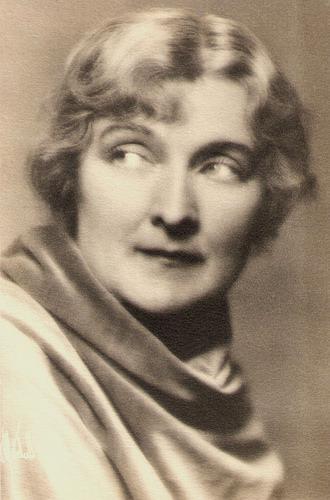
British card.
Not a classic beauty by any stretch
Agnes Sybil Thorndike was born in Gainsborough, Lincolnshire, in 1882. Her parents were Arthur Thorndike, a minor canon of Rochester Cathedral, and Agnes Macdonald. Sybil was the eldest of four children. One younger brother, Frank, was killed in WWI action, a tragedy that left her father inconsolable. He himself would die a few months later.
Sybil was educated at Rochester Grammar School for Girls, and first trained as a classical pianist, making weekly visits to London for music lessons at the Guildhall School of Music and Drama. She gave her first public performance as a pianist at the age of 11, but in 1899 was forced to give up playing owing to piano cramp.
At the instigation of her brother, the author Russell Thorndike, she then trained as an actress. Russell would later become a novelist and his sister's biographer.
Gary Brumburgh at IMDb : “Not a classic beauty by any stretch, Dame Sybil had sharp features, prominent cheek bones and a pronounced chin that gave her a rather severe look. At age 21 she and her brother began professionally in a touring company guided by actor-manager Ben Greet.”
She made her first stage appearance in Greet's 1904 production of William Shakespeare's The Merry Wives of Windsor. She went on to tour the USA in Shakespearean repertory for four years, playing some 112 roles.
In 1908, she was spotted by the playwright George Bernard Shaw when she understudied the leading role of Candida in a tour directed by Shaw himself. There she also met her future husband, Lewis Casson. They were married in 1908, and had four children: John (1909–1999), Christopher (1912–1996), Mary (1914–2009) and Ann (1915–1990). Thorndike was survived by her four children and a number of grandchildren and great-grandchildren when she died.
Sybil joined Annie Horniman's company in Manchester (1908–09 and 1911–13), went to Broadway in 1910, and then joined the Old Vic Company in London (1914–18), playing leading roles in Shakespeare and in other classic plays.
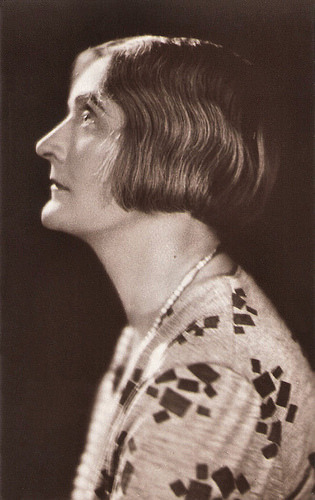
British card.
Saint Joan
After the war, Sybil Thorndike played Hecuba in Euripides' The Trojan Women (1919–20), then from 1920–22, she and her husband starred in a British version of France's Grand Guignol directed by Jose Levy.
She made her film debut in Moth and Rust (Sidney Morgan 1921), with Malvina Longfellow. The next year, she appeared in a large number of silent films, including versions of Bleak House (H.B. Parkinson, 1922), The Hunchback of Notre Dame/Esmeralda (Edwin J. Collins, 1922), Macbeth (H.B. Parkinson, 1922), The Merchant of Venice (Challis Sanderson, 1922) and The Scarlet Letter (Challis Sanderson, 1922).
She returned to the stage in the title role of George Bernard Shaw's Saint Joan in 1924, which had been written with her specifically in mind. The production was a huge success, and was revived repeatedly until her final performance in the role in 1941. In 1927, she appeared in a short film of Saint Joan made in the DeForest Phonofilm process, an excerpt of the play by George Bernard Shaw.
The following year she played Nurse Edith Cavell in the silent British war film Dawn (Herbert Wilcox, 1928). Cavell was a nurse who risked her own life by rescuing British Prisoners of War from the Germans. When Cavell was captured and sentenced to be executed, it sparked international outrage, even from neutral nations. Dawn was one of the most controversial British films of the 1920s. The film was censored because of what objectors considered its brutal depiction of warfare and anti-German sentiments. Pressure was exerted by both the German Ambassador and the British Foreign Secretary Austen Chamberlain to prevent the film being passed for exhibition.
Both Thorndike and Casson were active members of the Labour Party, and held strong left-wing views. Even when the 1926 General Strike stopped the first run of Saint Joan, they both still supported the strikers. As a pacifist, Thorndike was a member of the Peace Pledge Union and gave readings for its benefit.
She was made a Dame Commander of the Order of the British Empire in 1931. During World War II, Thorndike and her husband toured in Shakespearean productions on behalf of the Council For the Encouragement of the Arts, before joining Laurence Olivier and Ralph Richardson in the Old Vic season at the New Theatre in 1944.
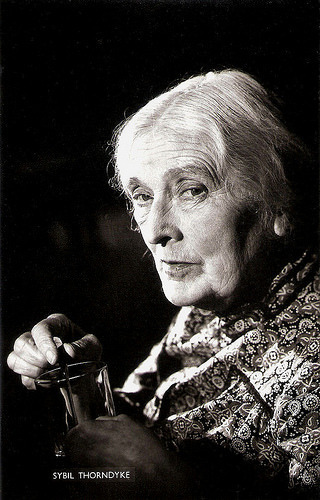
British card. Photo: publicity still for Uncle Vanya (1963).
There Was an Old Woman
Among Sybil Thorndike’s notable film roles were General Baines in Major Barbara (Gabriel Pascal, 1941), Mrs. Squeers in Nicholas Nickleby (Alberto Cavalcanti, 1948), Queen Victoria in Melba (Lewis Milestone, 1952) and the witty Queen Dowager in The Prince and the Showgirl (Laurence Olivier 1957) with Marilyn Monroe and Laurence Olivier , for which she was awarded the National Board of Review Award for Best Supporting Actress.
In the theatre, she continued to have success in such plays as N. C. Hunter's Waters of the Moon at the Haymarket in 1951-52. She also undertook tours of Australia and South Africa, before playing again with Laurence Olivier in Uncle Vanya at Chichester in 1962.
She made her last film appearance in a film version of Uncle Vanya (Stuart Burge, 1963) featuring Anthony Hopkins.
Thorndike made her farewell appearance with her husband in a London revival of Arsenic and Old Lace at the Vaudeville Theatre in 1966.
Her last stage performance was at the Thorndike Theatre in Leatherhead, Surrey, in There Was an Old Woman in 1969, the year Lewis Casson died.
Her final acting appearance was in the TV drama The Great Inimitable Mr Dickens (Ned Sherrin, 1970), with Anthony Hopkins. The same year she was made a Companion of Honour. She and her husband (who was knighted in 1945) were one of the few couples who both held titles in their own right.
In 1976 Dame Sybil Thorndike died in London, England at the age of 93. Her ashes are buried in Westminster Abbey.
Scene from The Prince and the Showgirl (1957). Source: serdarzzt (YouTube).
Sources: (IMDb), Wikipedia and .

British card.
Not a classic beauty by any stretch
Agnes Sybil Thorndike was born in Gainsborough, Lincolnshire, in 1882. Her parents were Arthur Thorndike, a minor canon of Rochester Cathedral, and Agnes Macdonald. Sybil was the eldest of four children. One younger brother, Frank, was killed in WWI action, a tragedy that left her father inconsolable. He himself would die a few months later.
Sybil was educated at Rochester Grammar School for Girls, and first trained as a classical pianist, making weekly visits to London for music lessons at the Guildhall School of Music and Drama. She gave her first public performance as a pianist at the age of 11, but in 1899 was forced to give up playing owing to piano cramp.
At the instigation of her brother, the author Russell Thorndike, she then trained as an actress. Russell would later become a novelist and his sister's biographer.
Gary Brumburgh at IMDb : “Not a classic beauty by any stretch, Dame Sybil had sharp features, prominent cheek bones and a pronounced chin that gave her a rather severe look. At age 21 she and her brother began professionally in a touring company guided by actor-manager Ben Greet.”
She made her first stage appearance in Greet's 1904 production of William Shakespeare's The Merry Wives of Windsor. She went on to tour the USA in Shakespearean repertory for four years, playing some 112 roles.
In 1908, she was spotted by the playwright George Bernard Shaw when she understudied the leading role of Candida in a tour directed by Shaw himself. There she also met her future husband, Lewis Casson. They were married in 1908, and had four children: John (1909–1999), Christopher (1912–1996), Mary (1914–2009) and Ann (1915–1990). Thorndike was survived by her four children and a number of grandchildren and great-grandchildren when she died.
Sybil joined Annie Horniman's company in Manchester (1908–09 and 1911–13), went to Broadway in 1910, and then joined the Old Vic Company in London (1914–18), playing leading roles in Shakespeare and in other classic plays.

British card.
Saint Joan
After the war, Sybil Thorndike played Hecuba in Euripides' The Trojan Women (1919–20), then from 1920–22, she and her husband starred in a British version of France's Grand Guignol directed by Jose Levy.
She made her film debut in Moth and Rust (Sidney Morgan 1921), with Malvina Longfellow. The next year, she appeared in a large number of silent films, including versions of Bleak House (H.B. Parkinson, 1922), The Hunchback of Notre Dame/Esmeralda (Edwin J. Collins, 1922), Macbeth (H.B. Parkinson, 1922), The Merchant of Venice (Challis Sanderson, 1922) and The Scarlet Letter (Challis Sanderson, 1922).
She returned to the stage in the title role of George Bernard Shaw's Saint Joan in 1924, which had been written with her specifically in mind. The production was a huge success, and was revived repeatedly until her final performance in the role in 1941. In 1927, she appeared in a short film of Saint Joan made in the DeForest Phonofilm process, an excerpt of the play by George Bernard Shaw.
The following year she played Nurse Edith Cavell in the silent British war film Dawn (Herbert Wilcox, 1928). Cavell was a nurse who risked her own life by rescuing British Prisoners of War from the Germans. When Cavell was captured and sentenced to be executed, it sparked international outrage, even from neutral nations. Dawn was one of the most controversial British films of the 1920s. The film was censored because of what objectors considered its brutal depiction of warfare and anti-German sentiments. Pressure was exerted by both the German Ambassador and the British Foreign Secretary Austen Chamberlain to prevent the film being passed for exhibition.
Both Thorndike and Casson were active members of the Labour Party, and held strong left-wing views. Even when the 1926 General Strike stopped the first run of Saint Joan, they both still supported the strikers. As a pacifist, Thorndike was a member of the Peace Pledge Union and gave readings for its benefit.
She was made a Dame Commander of the Order of the British Empire in 1931. During World War II, Thorndike and her husband toured in Shakespearean productions on behalf of the Council For the Encouragement of the Arts, before joining Laurence Olivier and Ralph Richardson in the Old Vic season at the New Theatre in 1944.

British card. Photo: publicity still for Uncle Vanya (1963).
There Was an Old Woman
Among Sybil Thorndike’s notable film roles were General Baines in Major Barbara (Gabriel Pascal, 1941), Mrs. Squeers in Nicholas Nickleby (Alberto Cavalcanti, 1948), Queen Victoria in Melba (Lewis Milestone, 1952) and the witty Queen Dowager in The Prince and the Showgirl (Laurence Olivier 1957) with Marilyn Monroe and Laurence Olivier , for which she was awarded the National Board of Review Award for Best Supporting Actress.
In the theatre, she continued to have success in such plays as N. C. Hunter's Waters of the Moon at the Haymarket in 1951-52. She also undertook tours of Australia and South Africa, before playing again with Laurence Olivier in Uncle Vanya at Chichester in 1962.
She made her last film appearance in a film version of Uncle Vanya (Stuart Burge, 1963) featuring Anthony Hopkins.
Thorndike made her farewell appearance with her husband in a London revival of Arsenic and Old Lace at the Vaudeville Theatre in 1966.
Her last stage performance was at the Thorndike Theatre in Leatherhead, Surrey, in There Was an Old Woman in 1969, the year Lewis Casson died.
Her final acting appearance was in the TV drama The Great Inimitable Mr Dickens (Ned Sherrin, 1970), with Anthony Hopkins. The same year she was made a Companion of Honour. She and her husband (who was knighted in 1945) were one of the few couples who both held titles in their own right.
In 1976 Dame Sybil Thorndike died in London, England at the age of 93. Her ashes are buried in Westminster Abbey.
Scene from The Prince and the Showgirl (1957). Source: serdarzzt (YouTube).
Sources: (IMDb), Wikipedia and .
Published on May 04, 2014 23:00
May 3, 2014
Robert Hossein
French director, writer and actor Robert Hossein (1927) was generally cast as a tough guy beside such gorgeous actresses as Brigitte Bardot, Sophia Loren and Marina Vlady. He is most famous though as Michèle Mercier's husband in the wildly popular Angélique series of the 1960s.
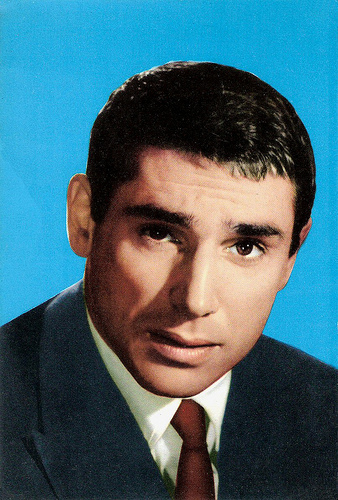
Spanish postcard by Postalco, Barcelona, no. 21/2. Photo: Unifrance Film.
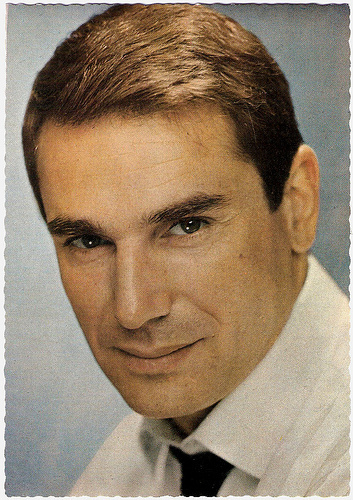
French postcard by E.D.U.G., no. 470. Photo: Sam Lévin.
Rififi
Robert Hossein was born as Robert Hosseinoff in Paris in 1927. He was the son of Aminollah (André) Hossein, a French orchestra conductor and composer of Persian-Azeri descent, and Anna Minevskaya, a Jewish comedy actress from Kiev.
Robert was trained at René Simon's acting school. He laboured away as actor/director with the legendary Theatre Grand Guignol in Montmartre, then spent several years on the ‘legitimate’ stage.
He made his first film appearance in a bit part in Les souvenirs ne sont pas à vendre/Sextette (Robert Hennion, 1948) with Martine Carol , and he had his breakthrough with the classic Film-Noir Du rififi chez les hommes/Rififi (Jules Dassin, 1955) as a slightly sadistic drug-addict.
The role of the jaded criminal stuck with him in the coming decades. Hossein also started directing with the thriller Les salauds vont en enfer/The Wicked Go to Hell (Robert Hossein, 1956) in which he co-starred with his wife, Marina Vlady .
The film was based on a play by Frédéric Dard whose novels and plays went on to furnish Hossein with much of his later film material such as the Film-Noir Toi... le venin/Blonde in a White Car (Robert Hossein, 1958), in which he again co-starred with Vlady, and with her sister Odile Versois .
Wikipedia notes: “Right from the start Hossein established his characteristic trademarks: using a seemingly straightforward suspense plot and subverting its conventions (sometimes to the extent of a complete disregard of the traditional demand for a final twist or revelation) in order to concentrate on ritualistic relationships. This is the director's running preoccupation which is always stressed in his films by an extraordinary command of film space and often striking frame compositions where the geometry of human figures and set design is used to accentuate the psychological set-up of the scene. The mechanisms of guilt and the way it destroys relationships is another recurring theme, presumably influenced by Hossein's lifelong interest in the works of Dostoyevski.”
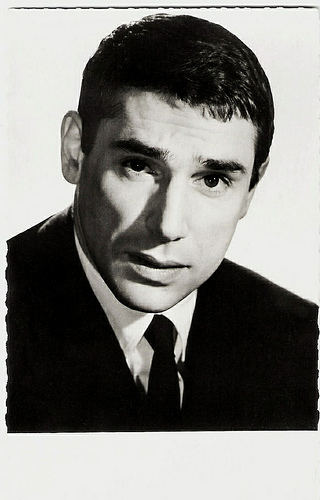
French postcard by Editions P.I., offered by Les Carbones Korès Carboplane, no. 906. Photo: Sam Lévin.
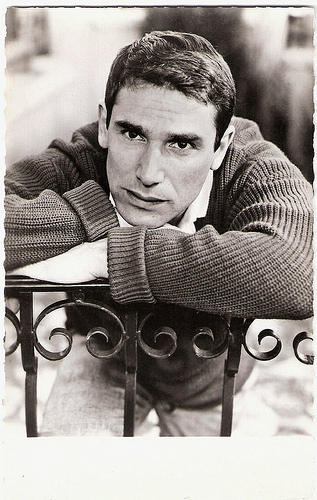
French postcard by Editions P.I., Paris, no. 949. Photo: Studio Bernard & Vauclair.
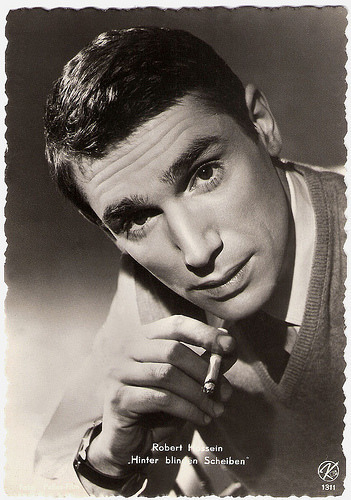
Austrian postcard by Kellner-Fotokarten, Wien, no. 1311. Photo: publicity still for Méfiez-vous, fillettes!/Good Girls Beware! (Yves Allégret, 1957).

East-German postcard by VEB Progress Film-Vertrieb, Berlin, no. 1842, 1963. Retail price: 0,20 DM. Publicity still for La liberté surveillée/Provisional Liberty (Henri Aisner, Vladimír Vlcek, 1958) with Marina Vlady.
Unashamedly Melodramatic Frameworks
As a director Robert Hossein had some modest international successes with films like Le vampire de Düsseldorf/The Vampire of Dusseldorf (Robert Hossein, 1965), but he was much singled out for scorching criticism by the critics and followers of the Nouvelle Vague for the unashamedly melodramatic frameworks of his films.
The fact that he was essentially an auteur director with a consistent set of themes and an extraordinary mastery of original and unusual approaches to staging his stories, was never appreciated. He was not averse to trying his hand at widely different genres and was never defeated, making the strikingly different spaghetti western Une corde, un Colt/The Rope and the Colt (Robert Hossein, 1969) and the low-budgeted but daringly subversive period drama J'ai tué Raspoutine/Rasputin (Robert Hossein, 1967) starring Gert Fröbe.
However, because of the lack of wider success and continuing adverse criticism, Hossein virtually ended his film directing career in 1970, and concentrated on the theatre where his achievements were never questioned.
However, in 1982, he directed the film adaption of Victor Hugo’s classic literary masterpiece, Les Misérables (Robert Hossein, 1982) with Lino Ventura as Jean Valjean.
James Travers writes in his review at Films de France : “The film’s exceptional production values are enhanced by Hossein’s own stylised approach, which gives the film a sense of authenticity and surprising modernity.”
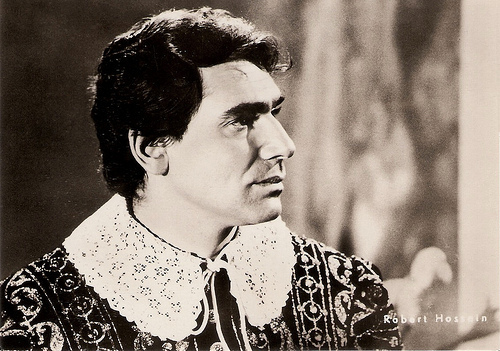
East-German postcard by VEB Progress Film-Vertrieb, Berlin, no. 32/71. Retail price: 0,20 M.
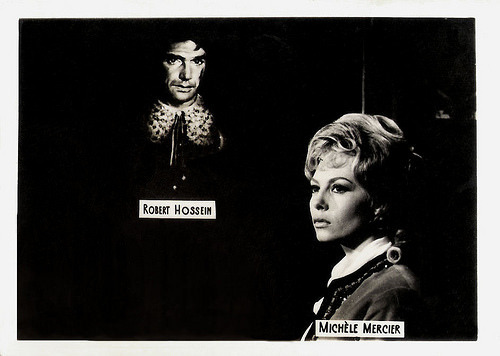
Romanian mini-card. With Michèlé Mercier in one of the Angelique films.
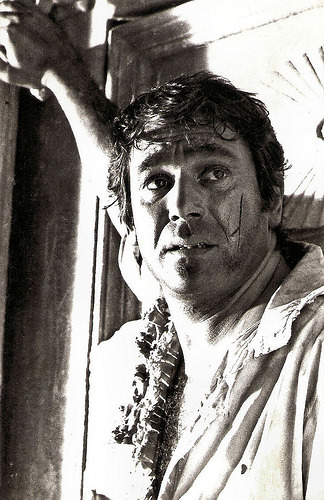
Romanian postcard by Casa Filmului Acin, no. 277. Photo: publicity still for Angelique et le sultan/Angelique and the Sultan (Bernard Borderie, 1968).

Romanian postcard by Casa Filmului Acin. Publicity still for Indomptable Angelique/Untamable Angelique (Bernard Borderie, 1967).
Angélique
Robert Hossein’s most famous role was as Michèle Mercier 's husband Jeoffrey de Peyrac in the historical romance/adventure Angélique, marquise des anges/Angélique (Bernard Borderie, 1964) and its four sequels.
Other films in which he appeared were Crime et châtiment/Crime and Punishment (Georges Lampin, 1956) starring Jean Gabin , Madame Sans-Gêne (Christian-Jaque, 1961) opposite Sophia Loren , and the Marquis de Sade adaptation Le vice et la vertu/Vice and Virtue (Roger Vadim, 1963) with Catherine Deneuve .
In the 1970s and 1980s he played opposite Jean Paul Belmondo in police thrillers like Le Casse/The Burglars (Henri Verneuil, 1971) and Le professionnel/The Professional (Georges Lautner, 1981).
He also appeared opposite Brigitte Bardot in one of her last films, Don Juan ou Si Don Juan était une femme.../Don Juan (Or If Don Juan Were a Woman) (Roger Vadim, 1973), and he was excellent as a Catholic priest who falls in love with Claude Jade and becomes a communist in Prêtres interdits/Forbidden Priests (Denys de La Patellière, 1973).
One of his most famous starring roles was as a pianist in the musical epic Les Uns et les Autres/Bolero (Claude Lelouch, 1981). In the theatre he directed popular historical vehicles involving large sets and numerous actors. Among his latest creations were Danton and Celui qui a dit non (Those Who Said No), a play on Charles de Gaulle and the French resistance.
At the age of 72, Hossein again played romantic love-scenes in a film, now with Audrey Tautou in Vénus beauté (institut)/Venus Beauty Institute (Tonie Marshall, 1999). He still regularly appears on TV and in films.
Robert Hossein was married three times: first to Marina Vlady (he has two sons with her, Pierre and Igor), later to Caroline Eliacheff (with whom he has a son, Nicholas). He is currently married to actress Candice Patou, with whom he has one son, Julien.
Trailer Angélique Marquise des Anges (1964). Source: Oldiestrailers (YouTube).
German Trailer for Une corde, un Colt (1969). Source: r6dw6c (YouTube).
Theatrical Trailer Le Professional (1981). Source: Classic Full Movie & Theatrical Trailer Collection (YouTube).
Scene from Les Misérables (1982)> Source: Gérard Roche (YouTube)
Sources: James Travers (Films de France), Hal Erickson (AllMovie), Darius Kadivar (The Iranian), Wikipedia, and .

Spanish postcard by Postalco, Barcelona, no. 21/2. Photo: Unifrance Film.

French postcard by E.D.U.G., no. 470. Photo: Sam Lévin.
Rififi
Robert Hossein was born as Robert Hosseinoff in Paris in 1927. He was the son of Aminollah (André) Hossein, a French orchestra conductor and composer of Persian-Azeri descent, and Anna Minevskaya, a Jewish comedy actress from Kiev.
Robert was trained at René Simon's acting school. He laboured away as actor/director with the legendary Theatre Grand Guignol in Montmartre, then spent several years on the ‘legitimate’ stage.
He made his first film appearance in a bit part in Les souvenirs ne sont pas à vendre/Sextette (Robert Hennion, 1948) with Martine Carol , and he had his breakthrough with the classic Film-Noir Du rififi chez les hommes/Rififi (Jules Dassin, 1955) as a slightly sadistic drug-addict.
The role of the jaded criminal stuck with him in the coming decades. Hossein also started directing with the thriller Les salauds vont en enfer/The Wicked Go to Hell (Robert Hossein, 1956) in which he co-starred with his wife, Marina Vlady .
The film was based on a play by Frédéric Dard whose novels and plays went on to furnish Hossein with much of his later film material such as the Film-Noir Toi... le venin/Blonde in a White Car (Robert Hossein, 1958), in which he again co-starred with Vlady, and with her sister Odile Versois .
Wikipedia notes: “Right from the start Hossein established his characteristic trademarks: using a seemingly straightforward suspense plot and subverting its conventions (sometimes to the extent of a complete disregard of the traditional demand for a final twist or revelation) in order to concentrate on ritualistic relationships. This is the director's running preoccupation which is always stressed in his films by an extraordinary command of film space and often striking frame compositions where the geometry of human figures and set design is used to accentuate the psychological set-up of the scene. The mechanisms of guilt and the way it destroys relationships is another recurring theme, presumably influenced by Hossein's lifelong interest in the works of Dostoyevski.”

French postcard by Editions P.I., offered by Les Carbones Korès Carboplane, no. 906. Photo: Sam Lévin.

French postcard by Editions P.I., Paris, no. 949. Photo: Studio Bernard & Vauclair.

Austrian postcard by Kellner-Fotokarten, Wien, no. 1311. Photo: publicity still for Méfiez-vous, fillettes!/Good Girls Beware! (Yves Allégret, 1957).

East-German postcard by VEB Progress Film-Vertrieb, Berlin, no. 1842, 1963. Retail price: 0,20 DM. Publicity still for La liberté surveillée/Provisional Liberty (Henri Aisner, Vladimír Vlcek, 1958) with Marina Vlady.
Unashamedly Melodramatic Frameworks
As a director Robert Hossein had some modest international successes with films like Le vampire de Düsseldorf/The Vampire of Dusseldorf (Robert Hossein, 1965), but he was much singled out for scorching criticism by the critics and followers of the Nouvelle Vague for the unashamedly melodramatic frameworks of his films.
The fact that he was essentially an auteur director with a consistent set of themes and an extraordinary mastery of original and unusual approaches to staging his stories, was never appreciated. He was not averse to trying his hand at widely different genres and was never defeated, making the strikingly different spaghetti western Une corde, un Colt/The Rope and the Colt (Robert Hossein, 1969) and the low-budgeted but daringly subversive period drama J'ai tué Raspoutine/Rasputin (Robert Hossein, 1967) starring Gert Fröbe.
However, because of the lack of wider success and continuing adverse criticism, Hossein virtually ended his film directing career in 1970, and concentrated on the theatre where his achievements were never questioned.
However, in 1982, he directed the film adaption of Victor Hugo’s classic literary masterpiece, Les Misérables (Robert Hossein, 1982) with Lino Ventura as Jean Valjean.
James Travers writes in his review at Films de France : “The film’s exceptional production values are enhanced by Hossein’s own stylised approach, which gives the film a sense of authenticity and surprising modernity.”

East-German postcard by VEB Progress Film-Vertrieb, Berlin, no. 32/71. Retail price: 0,20 M.

Romanian mini-card. With Michèlé Mercier in one of the Angelique films.

Romanian postcard by Casa Filmului Acin, no. 277. Photo: publicity still for Angelique et le sultan/Angelique and the Sultan (Bernard Borderie, 1968).

Romanian postcard by Casa Filmului Acin. Publicity still for Indomptable Angelique/Untamable Angelique (Bernard Borderie, 1967).
Angélique
Robert Hossein’s most famous role was as Michèle Mercier 's husband Jeoffrey de Peyrac in the historical romance/adventure Angélique, marquise des anges/Angélique (Bernard Borderie, 1964) and its four sequels.
Other films in which he appeared were Crime et châtiment/Crime and Punishment (Georges Lampin, 1956) starring Jean Gabin , Madame Sans-Gêne (Christian-Jaque, 1961) opposite Sophia Loren , and the Marquis de Sade adaptation Le vice et la vertu/Vice and Virtue (Roger Vadim, 1963) with Catherine Deneuve .
In the 1970s and 1980s he played opposite Jean Paul Belmondo in police thrillers like Le Casse/The Burglars (Henri Verneuil, 1971) and Le professionnel/The Professional (Georges Lautner, 1981).
He also appeared opposite Brigitte Bardot in one of her last films, Don Juan ou Si Don Juan était une femme.../Don Juan (Or If Don Juan Were a Woman) (Roger Vadim, 1973), and he was excellent as a Catholic priest who falls in love with Claude Jade and becomes a communist in Prêtres interdits/Forbidden Priests (Denys de La Patellière, 1973).
One of his most famous starring roles was as a pianist in the musical epic Les Uns et les Autres/Bolero (Claude Lelouch, 1981). In the theatre he directed popular historical vehicles involving large sets and numerous actors. Among his latest creations were Danton and Celui qui a dit non (Those Who Said No), a play on Charles de Gaulle and the French resistance.
At the age of 72, Hossein again played romantic love-scenes in a film, now with Audrey Tautou in Vénus beauté (institut)/Venus Beauty Institute (Tonie Marshall, 1999). He still regularly appears on TV and in films.
Robert Hossein was married three times: first to Marina Vlady (he has two sons with her, Pierre and Igor), later to Caroline Eliacheff (with whom he has a son, Nicholas). He is currently married to actress Candice Patou, with whom he has one son, Julien.
Trailer Angélique Marquise des Anges (1964). Source: Oldiestrailers (YouTube).
German Trailer for Une corde, un Colt (1969). Source: r6dw6c (YouTube).
Theatrical Trailer Le Professional (1981). Source: Classic Full Movie & Theatrical Trailer Collection (YouTube).
Scene from Les Misérables (1982)> Source: Gérard Roche (YouTube)
Sources: James Travers (Films de France), Hal Erickson (AllMovie), Darius Kadivar (The Iranian), Wikipedia, and .
Published on May 03, 2014 23:00
May 2, 2014
Maria Schell
Pretty, wide-eyed Austrian leading lady Maria Schell (1926-2005) became one of the first film idols to the European post-war generation. With her ‘smile under tears’ she appeared in dozens of German and Austrian popular films, but she also starred in British, French, Italian, and Hollywood productions.
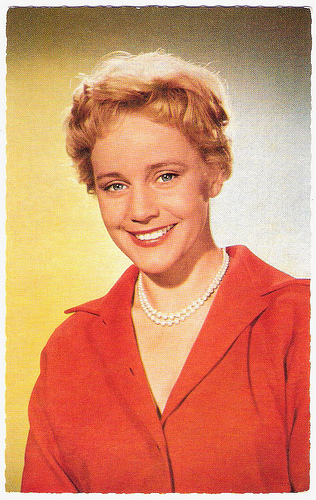
German postcard by Kolibri-Verlag G.m.b.H., Minden/Westf., no. F 27. Retail price: 25 Pfg. Photo: Ringpress / Vogelmann.
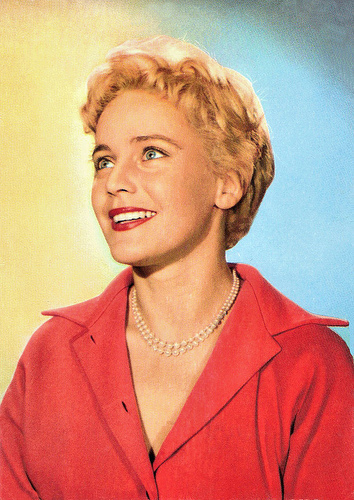
French postcard by Editions P.I., Paris, no. 74. Photo: Ufa / Vogelmann.
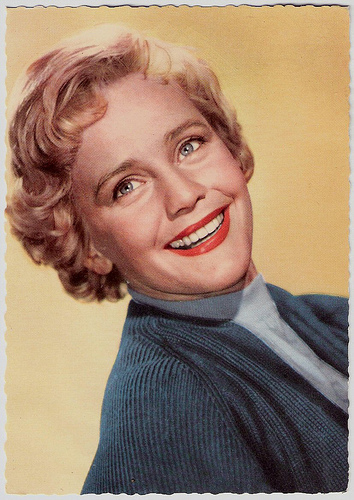
German postcard by Ufa (Universum-Film Aktiengesellschaft), Berlin-Tempelhof, no. CK-75. Retail price: 30 Pfg. Photo: Columbia Film.
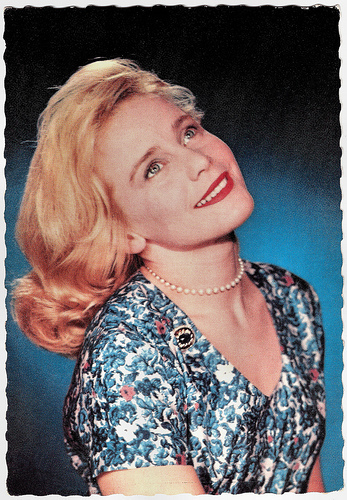
French postcard by Editions du Globe, Paris, no. 24. Photo: Sam Lévin.
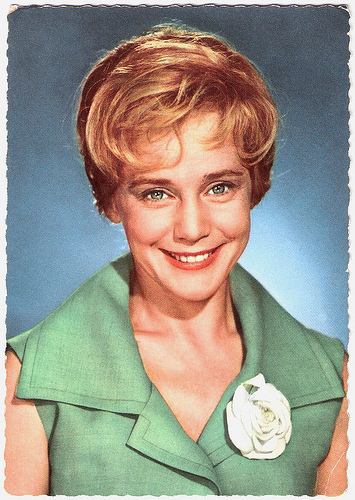
German postcard by UFA, no. CK-225. Retail price: 30 Pfg. Photo: Sam Lévin / UFA. Collection: Egbert Barten.
Escape
Margarete Schell was born in Vienna in 1926 as the daughter of the Swiss author Ferdinand Hermann Schell and Austrian actress Margarete Schell Noé. She was the older sister of the actors Immy, Carl, and Maximilian Schell .
Her family had to escape from the Nazi regime in 1938, and she received a dramatic training in Zurich, Switzerland. To pay her studies she worked as a secretary.
Billed as Gritli Schell, she made her screen debut at 16 in the Swiss-filmed drama Steibruch (Sigfrit Steiner, 1942).
It would be six years before she'd appear before the cameras again in Der Engel Mit der Posaune (Karl Hartl, 1948). This Austro-German production was simultaneously filmed in an English-language version, The Angel With the Trumpet (Anthony Bushell, 1950), which brought her to the attention of international filmgoers.
In the 1950s Maria often played the sweet and innocent Mädchen in numerous Austrian and German films. She starred opposite Dieter Borsche in popular melodramas like Es kommt ein Tag/A Day Will Come (Rudolf Jugert, 1950) and Dr. Holl (Rolf Hansen, 1951).
With O.W. Fischer she formed one of the 'Dream Couples of the German cinema' in romantic melodramas like Bis wir uns wiedersehen/Till We Meet Again (Gustav Ucicky, 1952), Der träumende Mund/Dreaming Lips (Josef von Báky, 1953), and Solange Du da bist/As Long As You're Near Me (Rolf Hansen, 1953).
She also starred in British productions like The Magic Box (John Boulting, 1951) with Robert Donat , and The Heart of the Matter (George More O'Ferrall, 1953) opposite Trevor Howard .
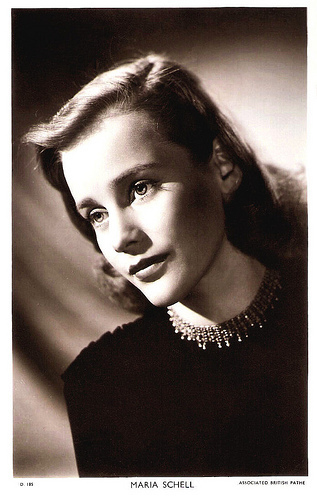
British postcard in the Picturegoer Series, London, no. D 185. Photo: Associated British Pathé.
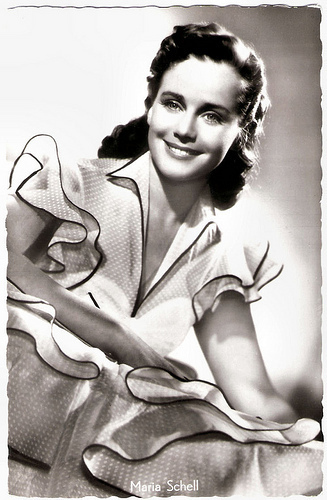
German postcard by Kolibri-Verlag, Minden/Westf., no. 831. Photo: NDF / Schorchtfilm.
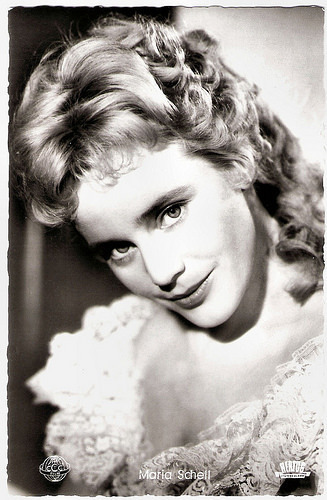
German postcard by Kolibri-Verlag, Minden/Westf., no. 1970. Photo: CCC Film / Herzog-film / Grimm. Publicity still for Liebe/Love (Horst Hächler, 1956).
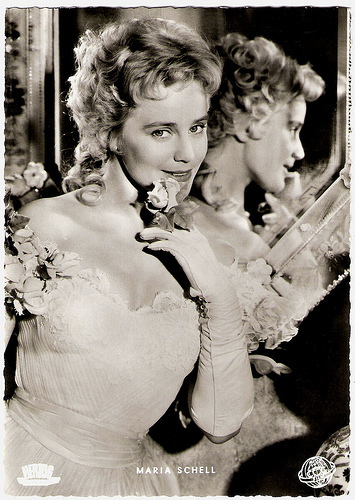
German postcard by Kunst und Bild, no F 7. Photo: CCC-Film / Herzog-Film / Grimm. Publicity still for Liebe/Love (Horst Hächler, 1956).
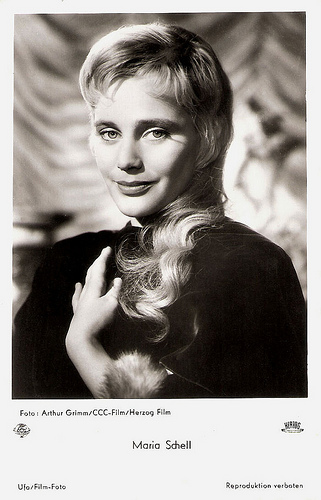
German postcard by Ufa, Berlin-Tempelhof, no. FK 3063. Photo: Arthur Grimm / CCC-Film / Herzog-Film.
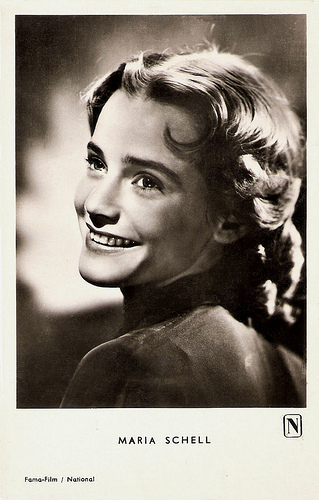
German postcard by Kunst und Bild, Berlin, no. A 038. Photo: Fama-Film / National.
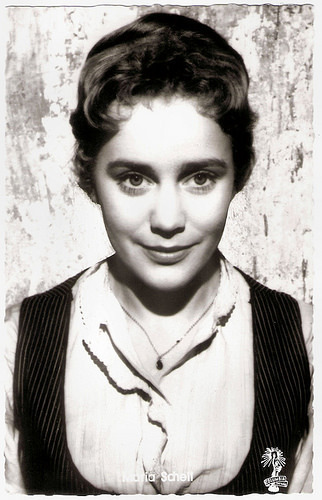
German postcard by Kolibri-Verlag, Minden/Westf., no. 2230. Photo: Columbia. Publicity still for Gervaise (René Clément, 1956).
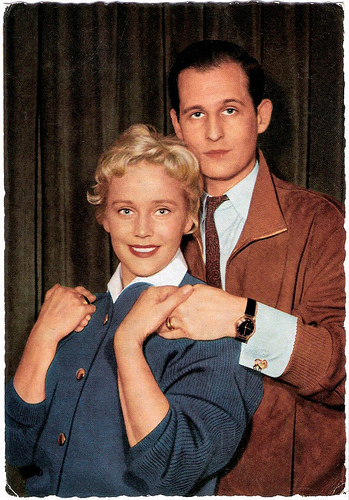
German card by WS-Druck, Wanne-Eickel, no. F 69. Photo: Ringpress. Maria Schell and director/writer/producer Horst Hächler were married from 1957 till 1965. They met during the production of Die Letzte Brücke/The Last Bridge (Helmut Käutner, 1954), for which he was the assistant director. Maria Schell played in two films directed by her husband, Liebe/Love (1957) and Raubfischer in Hellas/As the Sea Rages (1959). Their son, Oliver Hächler, is now known as the actor Oliver Schell.
Best Roles
In 1954, Maria Schell won a Cannes Film Festival award for her dramatic portrayal of a German nurse imprisoned in wartime Yugoslavia in Die letzte Brücke/The Last Bridge (Helmut Käutner, 1954).
Two years later, she claimed a Venice Film Festival prize for her role in Gervaise (René Clément, 1956). In this adaptation of Emile Zola’s L’Assommoir she played one of her best roles as a hardworking laundress surrounded by drunks.
Other important films were Robert Siodmak’s thriller Die Ratten/The Rats (1955), and Luchino Visconti’s romantic Fyodor Dostoyevski adaptation Le Notti bianche/White Nights (1957), with Schell as the young and innocent girl in love with Jean Marais but loved by Marcello Mastroianni .
Hollywood called and Maria Schell was contracted to star as Grushenka opposite Yul Brynner in The Brothers Karamazov (Richard Brooks, 1958), a messy adaptation of another classic novel by Dostoyevsky.
This was followed by roles in the Gary Cooper Western The Hanging Tree (Delmer Daves, 1959), the remake of Edna Ferber's Cimarron (Anthony Mann, 1961), and The Mark (Guy Green, 1961), opposite Academy Award nominee Stuart Whitman.
Then she returned to Germany for the family drama Das Riesenrad/The Giant Ferris Wheel (Géza von Radványi, 1961), again with O. W. Fischer .
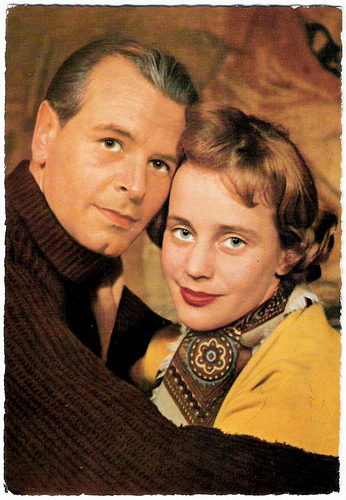
With O. W. Fischer .
German postcard by WS-Druck, Wanne-Eickel, nr. F 44. Photo: Klaus Collignon.
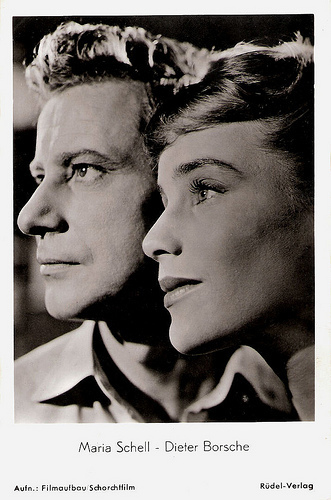
With Dieter Borsche . German postcard by F.J. Rüdel, Filmpostkartenverlag, Hamburg-Bergedorf, no. 560. Photo: Filmaufbau Schorchfilm. Publicity still for Es komt ein Tag/A Day Will Come (Rudolf Jugert, 1950).
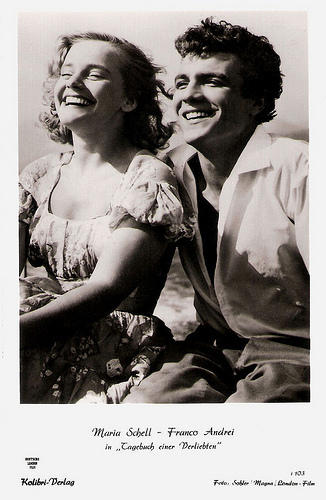
With Franco Andrei . German postcard by Kolibri-Verlag, no. I 103. Photo: Sohler / Magna / London-Film. Publicity still for Tagebuch einer Verliebten/The Diary of a Married Woman (Josef von Báky, 1953).
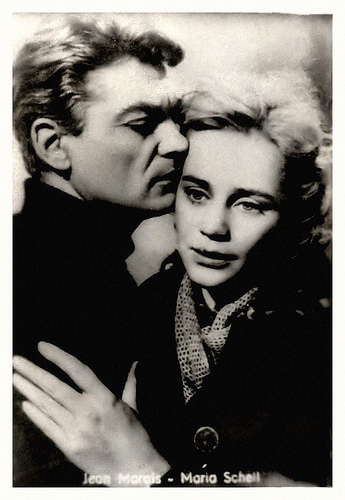
With Jean Marais . Photocard. Publicity still for Le notti bianche/ White Nights (Luchino Visconti, 1957).
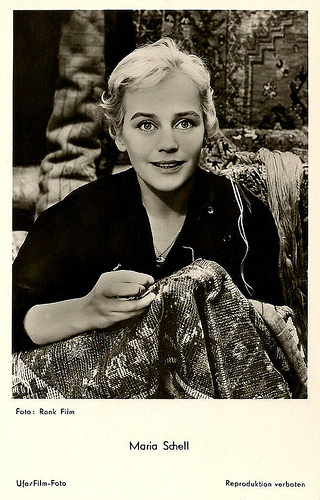
German postcard by Ufa. Photo: Rank. Still from Le notti bianche/White Nights (Luchino Visconti, 1957).
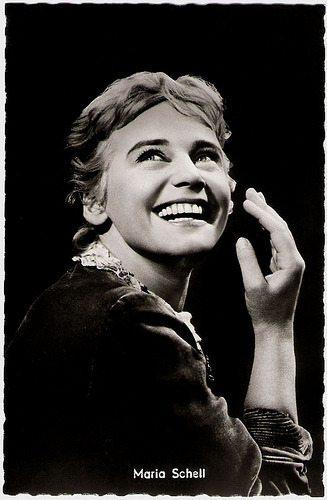
German postcard by Kolibri-Verlag G.m.b.H., Minden/Westf., no. 2754. Photo: Rank-Film. Publicity still for Le notti bianche/White Nights (Luchino Visconti, 1957).
Come-Back
In 1963, dissatisfied with the diminishing value of the characters she was called upon to play, Maria Schell retired.
But in 1969 she made a come-back with the witty French comedy Le Diable par la queue/The Devil By The Tail (Philippe de Broca, 1969) opposite Yves Montand .
Then followed two horror films by cult director Jesus Franco, Der Heisse Tod/ 99 Women (1969), and Il Trono di fuoco/Throne of the Blood Monster (1970), starring Christopher Lee.
Among her later assignments were Voyage of the Damned (Stuart Rosenberg, 1976), Superman: The Movie (Richard Donner, 1978), Schöner Gigolo, armer Gigolo/Just A Gigolo (David Hemmings, 1978) with David Bowie and Marlene Dietrich .
On TV she portrayed the mother of Nazi-architect Albert Speer ( Rutger Hauer ) in Inside the Third Reich (Marvin J. Chomsky, 1992). She also played Mother Maria in the TV sequel to Lilies of the Field called Christmas Lilies of the Field (Ralph Nelson, 1982), and she did guest appearances in popular crime series like Der Kommissar (1969-1975) starring Erik Ode, Kojak (1976) starring Telly Savalas, Derrick (1977-1978), and Tatort (1975-1996).
Besides being a film star; Maria Schell appeared in plays in Zurich, Basel, Vienna, Berlin, Munich, at the Salzburg Festival, and she went on provincial tours from 1963.
Among the plays she performed were such classics as Shakespeare's Hamlet, Goethe's Faust, and such modern classics as Pygmalion by George Bernard Shaw.
With her brother Maximilian Schell Maria only appeared in one film, the thriller The Odessa File (Ronald Neame, 1974).
In 2002 Maximilian made a documentary about her called Meine Schwester, Maria/My Sister, Maria, in which he documented how her mental health deteriorated along with her finances during her later years.
In 2005 Maria Schell died at age 79 of heart failure in her sleep. She was twice married, first to film director Horst Hächler and later to another film director, Veit Relin.
She was the mother of actor Oliver Schell, and of actress Marie-Therese Relin, who is married to Bavarian playwright Franz Xaver Kroetz, and has three children.
In 1974 Maria Schell was awarded the Bundesverdienstkreuz (Germany's Cross of Merit), and in 1977 the Filmband in Gold for her impressive contributions to the German cinema.
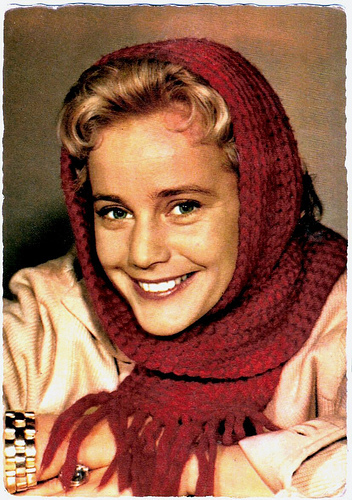
German postcard by Franz Josef Rüdel Filmpostkartenverlag, Hamburg-Bergedorf, no. FT 21. Photo: Bavaria / Schorcht / Gabriele. Publicity photo for Rose Bernd (Wolfgang Staudte, 1957).
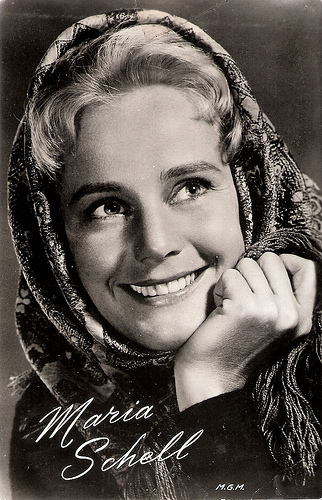
Dutch postcard by Uitg. Takken, Utrecht, no. 3752. Photo: M.G.M.
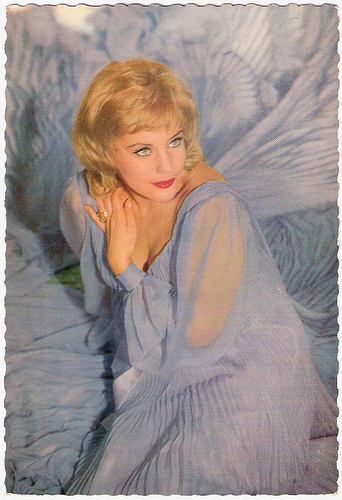
German postcard by Ufa (Universum-Film Aktiengesellschaft), Berlin-Tempelhof, no. CK 420. Retail price: 30 Pfg. Photo: Arthur Grimm / Ufa.
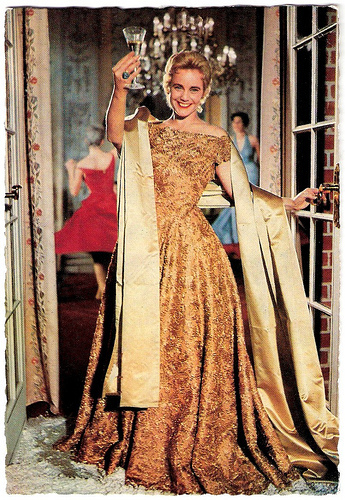
German postcard by WS Druck, Wanne-Eickel, no. F 68. Photo: Joe Niczky.
Scene from The Hanging Tree with Gary Cooper and Maria Schell. Source: Psychodad 1860 (YouTube).
Scene from Le Notti Bianche with Maria Schell and Marcello Mastroianni . Source: Nataniel Costard (YouTube).
Maria Schell: The actress that can smile while crying. Video tribute by Yamsala (YouTube).
Sources: Stephanie D'Heil (Steffie-line), (IMDb), Hal Erickson (AllMovie), Wikipedia, AbsoluteFacts.nl, and .

German postcard by Kolibri-Verlag G.m.b.H., Minden/Westf., no. F 27. Retail price: 25 Pfg. Photo: Ringpress / Vogelmann.

French postcard by Editions P.I., Paris, no. 74. Photo: Ufa / Vogelmann.

German postcard by Ufa (Universum-Film Aktiengesellschaft), Berlin-Tempelhof, no. CK-75. Retail price: 30 Pfg. Photo: Columbia Film.

French postcard by Editions du Globe, Paris, no. 24. Photo: Sam Lévin.

German postcard by UFA, no. CK-225. Retail price: 30 Pfg. Photo: Sam Lévin / UFA. Collection: Egbert Barten.
Escape
Margarete Schell was born in Vienna in 1926 as the daughter of the Swiss author Ferdinand Hermann Schell and Austrian actress Margarete Schell Noé. She was the older sister of the actors Immy, Carl, and Maximilian Schell .
Her family had to escape from the Nazi regime in 1938, and she received a dramatic training in Zurich, Switzerland. To pay her studies she worked as a secretary.
Billed as Gritli Schell, she made her screen debut at 16 in the Swiss-filmed drama Steibruch (Sigfrit Steiner, 1942).
It would be six years before she'd appear before the cameras again in Der Engel Mit der Posaune (Karl Hartl, 1948). This Austro-German production was simultaneously filmed in an English-language version, The Angel With the Trumpet (Anthony Bushell, 1950), which brought her to the attention of international filmgoers.
In the 1950s Maria often played the sweet and innocent Mädchen in numerous Austrian and German films. She starred opposite Dieter Borsche in popular melodramas like Es kommt ein Tag/A Day Will Come (Rudolf Jugert, 1950) and Dr. Holl (Rolf Hansen, 1951).
With O.W. Fischer she formed one of the 'Dream Couples of the German cinema' in romantic melodramas like Bis wir uns wiedersehen/Till We Meet Again (Gustav Ucicky, 1952), Der träumende Mund/Dreaming Lips (Josef von Báky, 1953), and Solange Du da bist/As Long As You're Near Me (Rolf Hansen, 1953).
She also starred in British productions like The Magic Box (John Boulting, 1951) with Robert Donat , and The Heart of the Matter (George More O'Ferrall, 1953) opposite Trevor Howard .

British postcard in the Picturegoer Series, London, no. D 185. Photo: Associated British Pathé.

German postcard by Kolibri-Verlag, Minden/Westf., no. 831. Photo: NDF / Schorchtfilm.

German postcard by Kolibri-Verlag, Minden/Westf., no. 1970. Photo: CCC Film / Herzog-film / Grimm. Publicity still for Liebe/Love (Horst Hächler, 1956).

German postcard by Kunst und Bild, no F 7. Photo: CCC-Film / Herzog-Film / Grimm. Publicity still for Liebe/Love (Horst Hächler, 1956).

German postcard by Ufa, Berlin-Tempelhof, no. FK 3063. Photo: Arthur Grimm / CCC-Film / Herzog-Film.

German postcard by Kunst und Bild, Berlin, no. A 038. Photo: Fama-Film / National.

German postcard by Kolibri-Verlag, Minden/Westf., no. 2230. Photo: Columbia. Publicity still for Gervaise (René Clément, 1956).

German card by WS-Druck, Wanne-Eickel, no. F 69. Photo: Ringpress. Maria Schell and director/writer/producer Horst Hächler were married from 1957 till 1965. They met during the production of Die Letzte Brücke/The Last Bridge (Helmut Käutner, 1954), for which he was the assistant director. Maria Schell played in two films directed by her husband, Liebe/Love (1957) and Raubfischer in Hellas/As the Sea Rages (1959). Their son, Oliver Hächler, is now known as the actor Oliver Schell.
Best Roles
In 1954, Maria Schell won a Cannes Film Festival award for her dramatic portrayal of a German nurse imprisoned in wartime Yugoslavia in Die letzte Brücke/The Last Bridge (Helmut Käutner, 1954).
Two years later, she claimed a Venice Film Festival prize for her role in Gervaise (René Clément, 1956). In this adaptation of Emile Zola’s L’Assommoir she played one of her best roles as a hardworking laundress surrounded by drunks.
Other important films were Robert Siodmak’s thriller Die Ratten/The Rats (1955), and Luchino Visconti’s romantic Fyodor Dostoyevski adaptation Le Notti bianche/White Nights (1957), with Schell as the young and innocent girl in love with Jean Marais but loved by Marcello Mastroianni .
Hollywood called and Maria Schell was contracted to star as Grushenka opposite Yul Brynner in The Brothers Karamazov (Richard Brooks, 1958), a messy adaptation of another classic novel by Dostoyevsky.
This was followed by roles in the Gary Cooper Western The Hanging Tree (Delmer Daves, 1959), the remake of Edna Ferber's Cimarron (Anthony Mann, 1961), and The Mark (Guy Green, 1961), opposite Academy Award nominee Stuart Whitman.
Then she returned to Germany for the family drama Das Riesenrad/The Giant Ferris Wheel (Géza von Radványi, 1961), again with O. W. Fischer .

With O. W. Fischer .
German postcard by WS-Druck, Wanne-Eickel, nr. F 44. Photo: Klaus Collignon.

With Dieter Borsche . German postcard by F.J. Rüdel, Filmpostkartenverlag, Hamburg-Bergedorf, no. 560. Photo: Filmaufbau Schorchfilm. Publicity still for Es komt ein Tag/A Day Will Come (Rudolf Jugert, 1950).

With Franco Andrei . German postcard by Kolibri-Verlag, no. I 103. Photo: Sohler / Magna / London-Film. Publicity still for Tagebuch einer Verliebten/The Diary of a Married Woman (Josef von Báky, 1953).

With Jean Marais . Photocard. Publicity still for Le notti bianche/ White Nights (Luchino Visconti, 1957).

German postcard by Ufa. Photo: Rank. Still from Le notti bianche/White Nights (Luchino Visconti, 1957).

German postcard by Kolibri-Verlag G.m.b.H., Minden/Westf., no. 2754. Photo: Rank-Film. Publicity still for Le notti bianche/White Nights (Luchino Visconti, 1957).
Come-Back
In 1963, dissatisfied with the diminishing value of the characters she was called upon to play, Maria Schell retired.
But in 1969 she made a come-back with the witty French comedy Le Diable par la queue/The Devil By The Tail (Philippe de Broca, 1969) opposite Yves Montand .
Then followed two horror films by cult director Jesus Franco, Der Heisse Tod/ 99 Women (1969), and Il Trono di fuoco/Throne of the Blood Monster (1970), starring Christopher Lee.
Among her later assignments were Voyage of the Damned (Stuart Rosenberg, 1976), Superman: The Movie (Richard Donner, 1978), Schöner Gigolo, armer Gigolo/Just A Gigolo (David Hemmings, 1978) with David Bowie and Marlene Dietrich .
On TV she portrayed the mother of Nazi-architect Albert Speer ( Rutger Hauer ) in Inside the Third Reich (Marvin J. Chomsky, 1992). She also played Mother Maria in the TV sequel to Lilies of the Field called Christmas Lilies of the Field (Ralph Nelson, 1982), and she did guest appearances in popular crime series like Der Kommissar (1969-1975) starring Erik Ode, Kojak (1976) starring Telly Savalas, Derrick (1977-1978), and Tatort (1975-1996).
Besides being a film star; Maria Schell appeared in plays in Zurich, Basel, Vienna, Berlin, Munich, at the Salzburg Festival, and she went on provincial tours from 1963.
Among the plays she performed were such classics as Shakespeare's Hamlet, Goethe's Faust, and such modern classics as Pygmalion by George Bernard Shaw.
With her brother Maximilian Schell Maria only appeared in one film, the thriller The Odessa File (Ronald Neame, 1974).
In 2002 Maximilian made a documentary about her called Meine Schwester, Maria/My Sister, Maria, in which he documented how her mental health deteriorated along with her finances during her later years.
In 2005 Maria Schell died at age 79 of heart failure in her sleep. She was twice married, first to film director Horst Hächler and later to another film director, Veit Relin.
She was the mother of actor Oliver Schell, and of actress Marie-Therese Relin, who is married to Bavarian playwright Franz Xaver Kroetz, and has three children.
In 1974 Maria Schell was awarded the Bundesverdienstkreuz (Germany's Cross of Merit), and in 1977 the Filmband in Gold for her impressive contributions to the German cinema.

German postcard by Franz Josef Rüdel Filmpostkartenverlag, Hamburg-Bergedorf, no. FT 21. Photo: Bavaria / Schorcht / Gabriele. Publicity photo for Rose Bernd (Wolfgang Staudte, 1957).

Dutch postcard by Uitg. Takken, Utrecht, no. 3752. Photo: M.G.M.

German postcard by Ufa (Universum-Film Aktiengesellschaft), Berlin-Tempelhof, no. CK 420. Retail price: 30 Pfg. Photo: Arthur Grimm / Ufa.

German postcard by WS Druck, Wanne-Eickel, no. F 68. Photo: Joe Niczky.
Scene from The Hanging Tree with Gary Cooper and Maria Schell. Source: Psychodad 1860 (YouTube).
Scene from Le Notti Bianche with Maria Schell and Marcello Mastroianni . Source: Nataniel Costard (YouTube).
Maria Schell: The actress that can smile while crying. Video tribute by Yamsala (YouTube).
Sources: Stephanie D'Heil (Steffie-line), (IMDb), Hal Erickson (AllMovie), Wikipedia, AbsoluteFacts.nl, and .
Published on May 02, 2014 23:00
May 1, 2014
Gina Palerme
French actress and singer Gina Palerme was the toast of the London music halls in the 1910s. In the next decade she played in numerous French silent films, and finished her career in the Moulin Rouge and other Paris cabarets.
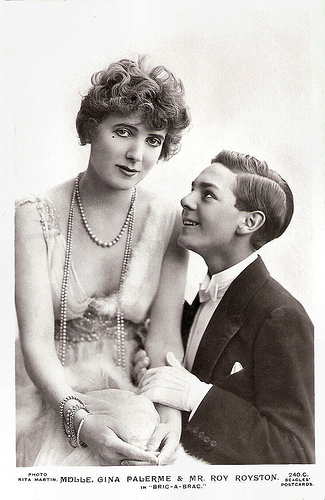
British postcard by J. Beagles & Co, London, no. 240 C. Photo: Rita Martin. Publicity still for the stage production Bric-a-brac (1915) with Roy Royston.
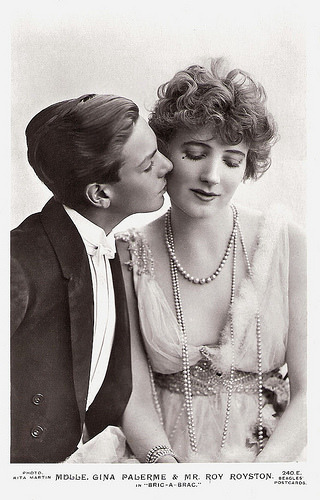
British postcard by J. Beagles & Co, London, no. 240 E. Photo: Rita Martin. Publicity still for the stage production Bric-a-brac (1915) again with Roy Royston.
The Glamour of the French Cocotte
Gina Palerme was discovered by a British entrepreneur. She debuted as Toinette in the musical comedy The Quaker Girl (Lionel Mockton, 1911) at the Adelphi Theatre.
Her début was followed by appearances in West-end productions like The Dancing Mistress (1912), Betty (1914), Platons Les Capucines (1914), Bric-a-Brac (1915), Vanity Fair (1916), La Petite Chocolatière (1917), Finsbury (1917), and The Girl for the Boy (1919).
Until 1919 Palerme was the toast of the London music hall. Cecil Beaton enthusiastically wrote about her: “Gina Palerme brought the glamour of the French cocotte to London. Her off-stage appearances were as sensational as her stage escapades...sometimes she wore a velvet tam-o'-shanter and men's riding breeches while relaxing in the richly ornate gilt of her Maida Vale drawing-room.”
The National Portrait Gallery holds beautiful photos from those years, made by the famous photographer Bassano and by his colleagues Rita Martin and The Dover Street Studios Ltd .
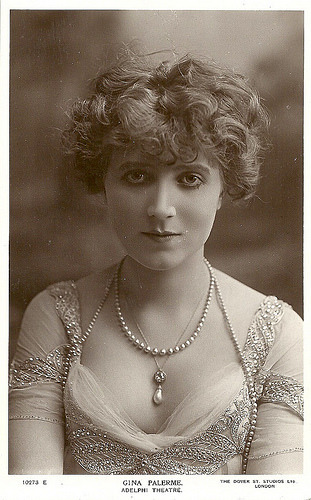
British postcard, no. 10273 E. Photo: The Dover Street Studios Ltd, London.
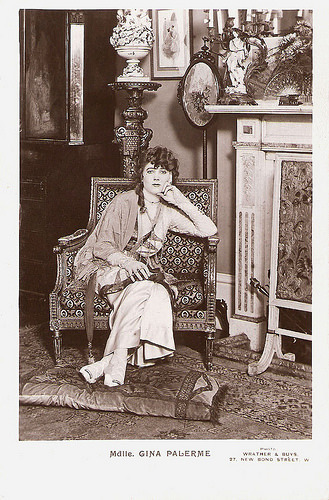
British postcard. Photo: Wrather & Buys, London.
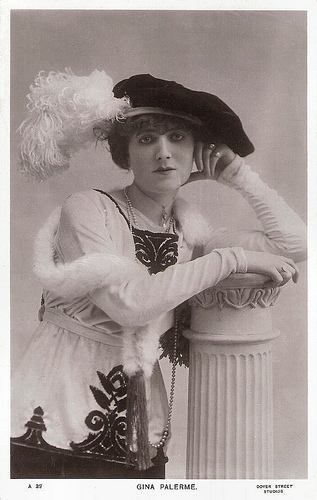
British postcard in the Arcadian Series, no. A 39. Photo: Dover Street Studios.
Horror Comedy
Gina Palerme returned to France in 1919.
In the early 1920s she played in various silent French films like L’éternel féminin/The Eternal Female (Roger Lion, 1921), Margot (Guy du Fresnay, 1922), L’idée de Françoise/Françoise's Idea (Robert Saidreau, 1923) in which she played the title role of the foreseeing Françoise, and the Halevy & Meilhac adaptation Frou-Frou (Guy du Fresnay, 1923).
La bataille/The Battle (1923) was co-directed by Edouard-Emile Viollet and Hollywood star Sessue Hayakawa who also played the male lead, together with his wife Tsuru Aoki.
Palerme also appeared with Hayakawa and Aoki in the American version of La bataille, The Danger Line (1924).
In the horror comedy Au secours!/Help! (Abel Gance, 1924) she co-starred with the great comic Max Linder . It was his last surviving work;
Her final film was La clé de voute/The Keystone (Roger Lion, 1925), which Palerme produced herself. It was a drama about a young female factory worker who gives away her child, but always repents.
After this film Gina Palerme quitted the cinema. From then on, she would only work in such French cabarets as the Moulin Rouge and the Concert Mayol.
More information about Palerme was not to be found on the net.
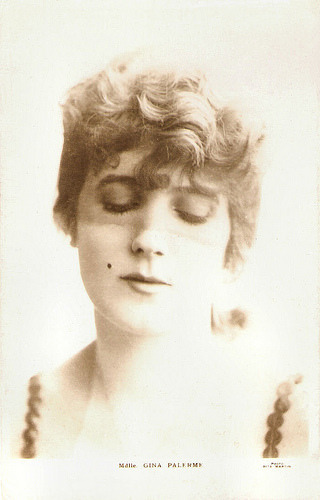
British postcard. Photo: Rita Martin.
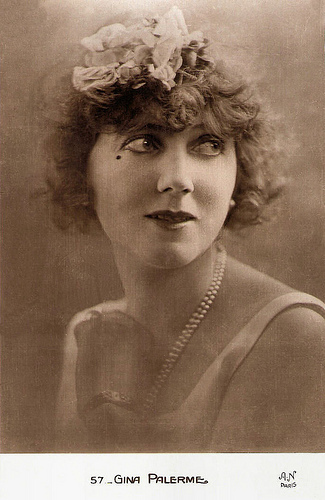
French postcard by A.N., Paris, no. 57.
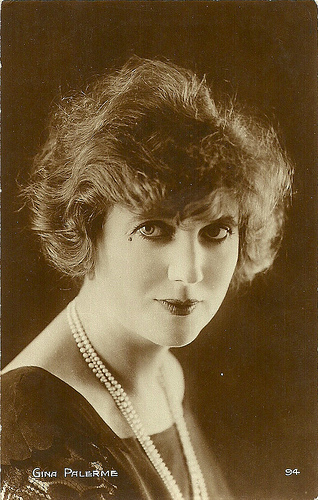
French postcard by Cinémagazine, no. 94.
Sources: John Culme (Footlight Notes), National Portrait Gallery, and .

British postcard by J. Beagles & Co, London, no. 240 C. Photo: Rita Martin. Publicity still for the stage production Bric-a-brac (1915) with Roy Royston.

British postcard by J. Beagles & Co, London, no. 240 E. Photo: Rita Martin. Publicity still for the stage production Bric-a-brac (1915) again with Roy Royston.
The Glamour of the French Cocotte
Gina Palerme was discovered by a British entrepreneur. She debuted as Toinette in the musical comedy The Quaker Girl (Lionel Mockton, 1911) at the Adelphi Theatre.
Her début was followed by appearances in West-end productions like The Dancing Mistress (1912), Betty (1914), Platons Les Capucines (1914), Bric-a-Brac (1915), Vanity Fair (1916), La Petite Chocolatière (1917), Finsbury (1917), and The Girl for the Boy (1919).
Until 1919 Palerme was the toast of the London music hall. Cecil Beaton enthusiastically wrote about her: “Gina Palerme brought the glamour of the French cocotte to London. Her off-stage appearances were as sensational as her stage escapades...sometimes she wore a velvet tam-o'-shanter and men's riding breeches while relaxing in the richly ornate gilt of her Maida Vale drawing-room.”
The National Portrait Gallery holds beautiful photos from those years, made by the famous photographer Bassano and by his colleagues Rita Martin and The Dover Street Studios Ltd .

British postcard, no. 10273 E. Photo: The Dover Street Studios Ltd, London.

British postcard. Photo: Wrather & Buys, London.

British postcard in the Arcadian Series, no. A 39. Photo: Dover Street Studios.
Horror Comedy
Gina Palerme returned to France in 1919.
In the early 1920s she played in various silent French films like L’éternel féminin/The Eternal Female (Roger Lion, 1921), Margot (Guy du Fresnay, 1922), L’idée de Françoise/Françoise's Idea (Robert Saidreau, 1923) in which she played the title role of the foreseeing Françoise, and the Halevy & Meilhac adaptation Frou-Frou (Guy du Fresnay, 1923).
La bataille/The Battle (1923) was co-directed by Edouard-Emile Viollet and Hollywood star Sessue Hayakawa who also played the male lead, together with his wife Tsuru Aoki.
Palerme also appeared with Hayakawa and Aoki in the American version of La bataille, The Danger Line (1924).
In the horror comedy Au secours!/Help! (Abel Gance, 1924) she co-starred with the great comic Max Linder . It was his last surviving work;
Her final film was La clé de voute/The Keystone (Roger Lion, 1925), which Palerme produced herself. It was a drama about a young female factory worker who gives away her child, but always repents.
After this film Gina Palerme quitted the cinema. From then on, she would only work in such French cabarets as the Moulin Rouge and the Concert Mayol.
More information about Palerme was not to be found on the net.

British postcard. Photo: Rita Martin.

French postcard by A.N., Paris, no. 57.

French postcard by Cinémagazine, no. 94.
Sources: John Culme (Footlight Notes), National Portrait Gallery, and .
Published on May 01, 2014 23:00
April 30, 2014
Andréa Parisy (1935-2014)
Brunette French film actress Andréa Parisy (1935-2014) died on 27 April 2014. She was best known as the leading lady opposite Louis de Funès in such comedies as Bébés à gogo/Babes a GoGo (Paul Mesnier, 1956), La grande vadrouille/Don't Look Now, We've Been Shot At (Gérard Oury, 1966) and Le Petit Baigneur/The Little Bather (Robert Dhéry, 1968), but she also appeared in the historical drama Mayerling (Terence Young, 1968), in which she played Princess Stéphanie of Belgium. Andréa Parisy was 78.
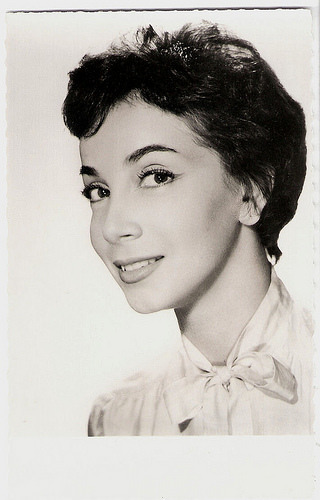
French postcard by Editions P.I., presented by Les Carbones Korès Carboplane, no. 961. Photo: Sam Lévin.
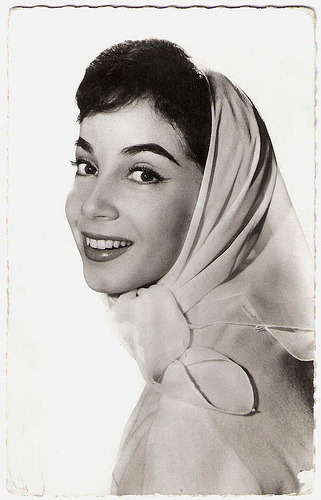
French postcard by Editions du Globe, no. 736. Photo: Sam Lévin.
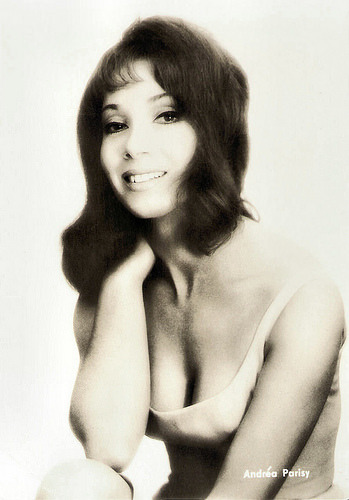
East-German postcard by VEB Progress Film-Vertrieb, Berlin, no. 114/70. Photo: Unifrance.
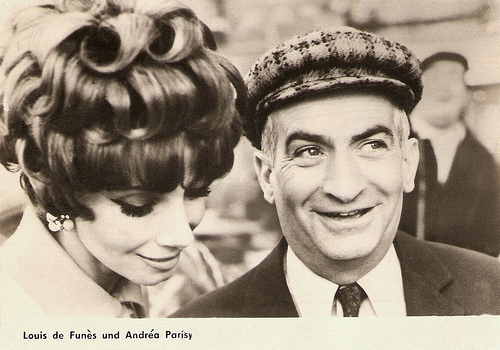
East-German postcard by VEB Progress Film-Verlag. Photo: publicity still for Le Petit Baigneur/The Little Bather (Robert Dhéry, 1968) with Louis de Funès .
Sources: Wikipedia and

French postcard by Editions P.I., presented by Les Carbones Korès Carboplane, no. 961. Photo: Sam Lévin.

French postcard by Editions du Globe, no. 736. Photo: Sam Lévin.

East-German postcard by VEB Progress Film-Vertrieb, Berlin, no. 114/70. Photo: Unifrance.

East-German postcard by VEB Progress Film-Verlag. Photo: publicity still for Le Petit Baigneur/The Little Bather (Robert Dhéry, 1968) with Louis de Funès .
Sources: Wikipedia and
Published on April 30, 2014 15:09
April 29, 2014
Marina von Ditmar
German-Baltic theatre and film actress Marina von Ditmar (1914) was a popular film star of the Third Reich.
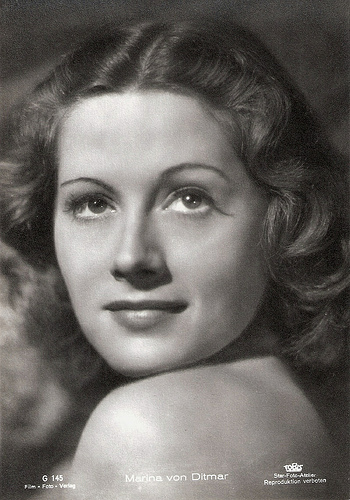
German postcard by Film-Foto-Verlag, no. G 145, 1941-1944. Photo: Tobis / Star-Foto-Atelier.
Münchhausen
Marina von Ditmar was born in Petrograd (now St. Petersburg), Russia, in 1914. She came from Baltic nobility.
In the mid-1930s Marina started to work as an actress in the theatre and from 1937 till 1939 she performed e.g. at the Volksbühne in Berlin.
Simultaneously she began to work for the Ufa studio. There she appeared in films like the operetta Das Czardasfürstin/The Csardas Princess (Georg Jacoby, 1934) with Márta Eggerth and Hans Söhnker , the Molière adaptation Der eingebildete Kranke/The Imaginary Invalid (Detlef Sierck (later: Douglas Sirk), 1935) and the drama Stadt Anatol/The City of Anatol (Viktor Tourjansky, 1936) with Brigitte Horney .
During the Third Reich she played in several Nazi propaganda films, such as Legion Condor (Karl Ritter, 1939) with Paul Hartmann , and Stukas (Karl Ritter, 1941) as a French girl alongside Carl Raddatz .
A highlight was het part as the enchanting Sophie von Riedesel in the lavish, adult fairy tale Münchhausen/The Adventures of Baron Munchausen (Josef von Báky, 1943) featuring popular film star Hans Albers .
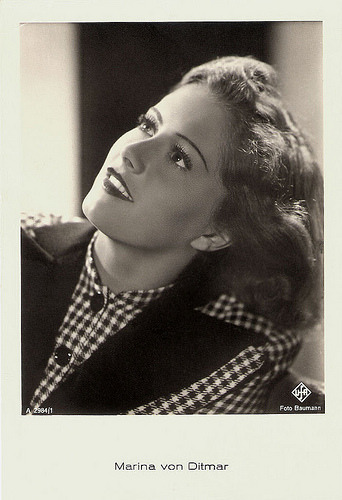
German postcard by Film-Foto-Verlag, no. A 2984/1, 1939-1940. Photo: Baumann / Ufa.
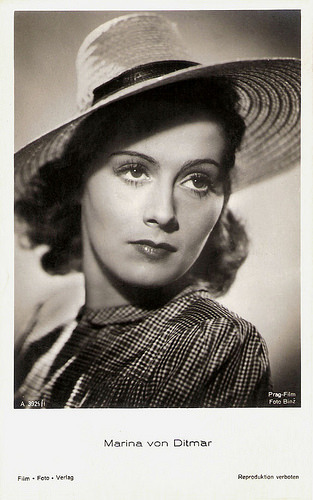
German postcard by Film-Foto-Verlag, no. A 3825/1, 1941-1944. Photo: Binz / Prag-Film.
Private Sanatorium
After the Second World War, Marina von Ditmar played only in a few more films. Her last films roles were supporting roles in the crime film Kronjuwelen/Crown Jewels (Frantisek Cáp, 1950) with Sybille Schmitz , and the comedy Mutter sein dagegen sehr (Viktor Tourjansky, 1951) featuring Ilse Werner .
In 1952 she finished her career, and completely withdrew from the spotlights.
She married doctor Hans-Georg Dehnhardt, chief doctor and owner of sanatorium Kurländer Haus in Bad Kissingen. Thanks to their personal contacts in the Beau Monde, the couple could receive in the following decades, many prominent guests in his private sanatorium.
Guests included the Thai royal couple Bhumibol and Sirikit Adulyadej and Federal President Heinrich Lübke and his wife.
Hans-Georg Dehnhardt died in 2001, but Marina Dehnhardt still lives in Bad Kissingen.
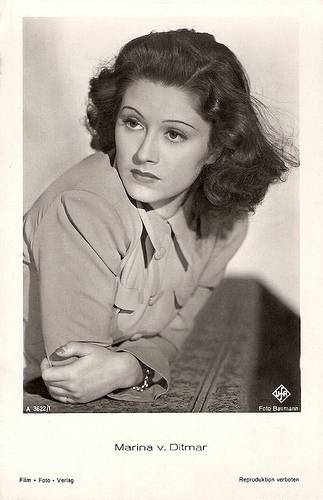
German postcard by Film-Foto-Verlag, no. A 3622/1, 1941-1944. Photo: Baumann / Ufa.
Source: Stephanie D’heil (Steffi-line) (German), Wikipedia (German), and .

German postcard by Film-Foto-Verlag, no. G 145, 1941-1944. Photo: Tobis / Star-Foto-Atelier.
Münchhausen
Marina von Ditmar was born in Petrograd (now St. Petersburg), Russia, in 1914. She came from Baltic nobility.
In the mid-1930s Marina started to work as an actress in the theatre and from 1937 till 1939 she performed e.g. at the Volksbühne in Berlin.
Simultaneously she began to work for the Ufa studio. There she appeared in films like the operetta Das Czardasfürstin/The Csardas Princess (Georg Jacoby, 1934) with Márta Eggerth and Hans Söhnker , the Molière adaptation Der eingebildete Kranke/The Imaginary Invalid (Detlef Sierck (later: Douglas Sirk), 1935) and the drama Stadt Anatol/The City of Anatol (Viktor Tourjansky, 1936) with Brigitte Horney .
During the Third Reich she played in several Nazi propaganda films, such as Legion Condor (Karl Ritter, 1939) with Paul Hartmann , and Stukas (Karl Ritter, 1941) as a French girl alongside Carl Raddatz .
A highlight was het part as the enchanting Sophie von Riedesel in the lavish, adult fairy tale Münchhausen/The Adventures of Baron Munchausen (Josef von Báky, 1943) featuring popular film star Hans Albers .

German postcard by Film-Foto-Verlag, no. A 2984/1, 1939-1940. Photo: Baumann / Ufa.

German postcard by Film-Foto-Verlag, no. A 3825/1, 1941-1944. Photo: Binz / Prag-Film.
Private Sanatorium
After the Second World War, Marina von Ditmar played only in a few more films. Her last films roles were supporting roles in the crime film Kronjuwelen/Crown Jewels (Frantisek Cáp, 1950) with Sybille Schmitz , and the comedy Mutter sein dagegen sehr (Viktor Tourjansky, 1951) featuring Ilse Werner .
In 1952 she finished her career, and completely withdrew from the spotlights.
She married doctor Hans-Georg Dehnhardt, chief doctor and owner of sanatorium Kurländer Haus in Bad Kissingen. Thanks to their personal contacts in the Beau Monde, the couple could receive in the following decades, many prominent guests in his private sanatorium.
Guests included the Thai royal couple Bhumibol and Sirikit Adulyadej and Federal President Heinrich Lübke and his wife.
Hans-Georg Dehnhardt died in 2001, but Marina Dehnhardt still lives in Bad Kissingen.

German postcard by Film-Foto-Verlag, no. A 3622/1, 1941-1944. Photo: Baumann / Ufa.
Source: Stephanie D’heil (Steffi-line) (German), Wikipedia (German), and .
Published on April 29, 2014 23:00
Renate Müller
Popular actress and singer Renate Müller (1906-1937) was the toast of late 1920s Berlin. She had a comet-like career in the early German sound cinema, which was abruptly ended by her mysterious death at the age of 31.
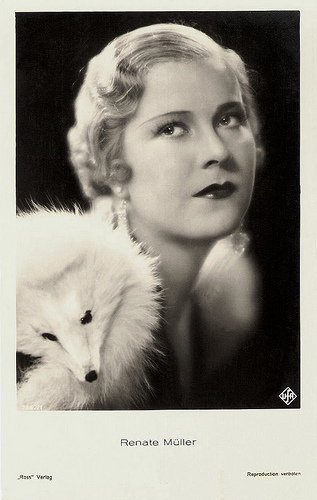
German postcard by Ross Verlag, no. 7867/1, 1932-1933. Photo: Ufa.
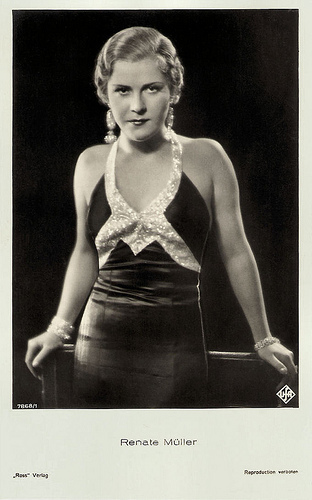 German postcard by Ross Verlag, no. 7868/1, 1932-1933. Photo: Ufa
German postcard by Ross Verlag, no. 7868/1, 1932-1933. Photo: Ufa
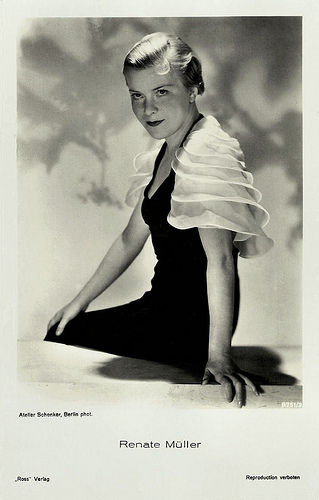
German postcard by Ross Verlag, no. 8751/2, 1933-1934. Photo: Atelier Schenker, Berlin.
Well-Trained Voice
Renate Müller was born in Munich, Germany, in 1906. Her father was one of Munich's leading newspaper publishers.
She was trained as a singer and a stage actress at the Max Reinhardt theatre school. Famous director G.W. Pabst reportedly gave her lessons there.
She started acting on stage in the second half of the 1920's, at the Berlin Lessing Theater, and played opposite famous actor Alexander Moissi on-stage in Zweimal Oliver/Oliver Twice.
A blue-eyed blonde, she was considered to be one of the great beauties of her day. Director Reinhold Schünzel let her make her film debut with the comedy Peter, der Matrose/Peter the Sailor (1929).
That was still a silent film, but Müller would soon flourish in the German sound film, for which her well-trained voice came in handy. She played in the German version of Italy's first sound film, Gennaro Righelli's La canzone dell'amore, Liebeslied/Love Song (Constantin J. David, 1931) with Gustav Fröhlich .
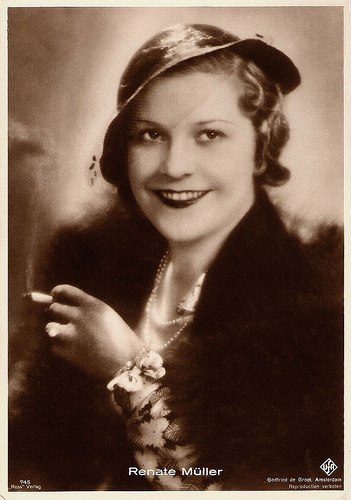
German postcard by Ross Verlag, no. 745. Photo: Godfried de Groot, Amsterdam.
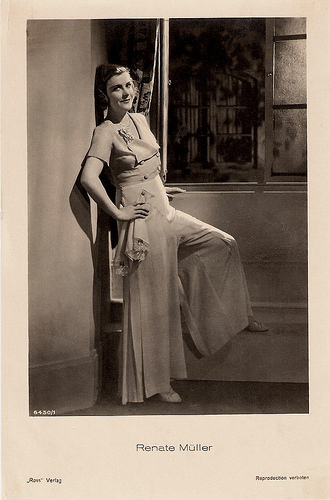
German postcard by Ross Verlag, no. 6450/1, 1931-1932.
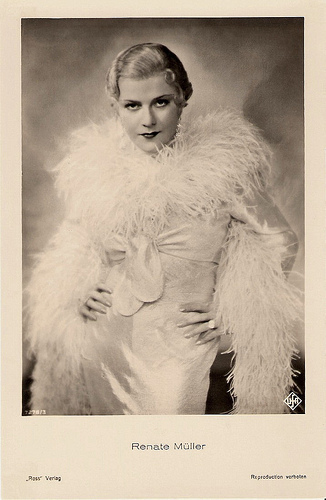
German postcard by Ross Verlag, no. 7278/3, 1932-1933. Photo: Ufa.
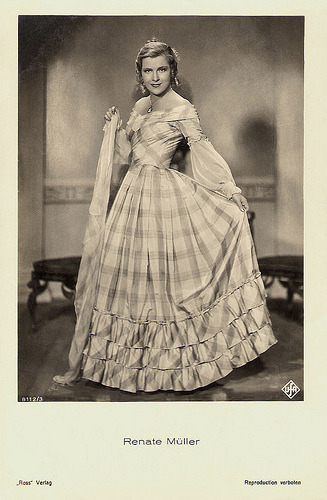
German postcard by Ross Verlag, no. 8113/1, 1933-1934. Photo: Ufa / Atelier Jacobi, Berlin.
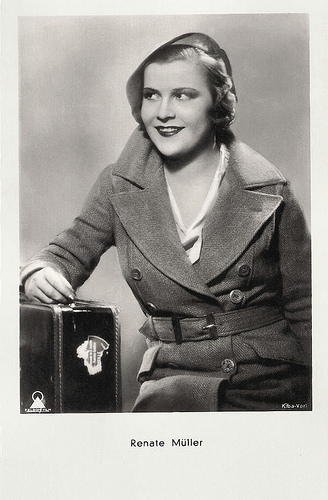
Austrian postcard by Iris Verlag / Amag, no. 6497. Photo: Felsom-Film / Kiba-Verleih.
Natural and Self-conscious Woman
Renate Müller played often the natural, self-conscious young woman who knows what she wants, opposing the sweet girls and vamps of the 1920s. And thus we see her in films such as the singing secretary in Die Privatsekretärin/Private Secretary (Wilhelm Thiele, 1931), of which her song Ich bin ja heut' so glücklich became a smash hit.
In the simultaneously made English version, Sunshine Susie (Victor Saville, 1932), Müller also starred, and now she sang Today I am so happy.
There were also a French version, Dactylo, with Marie Glory , and an Italian version, La segretaria privata, with Elsa Merlini who sang Oh come son' felice, felice, felice.
At AllMovie , Hans J. Wollstein writes: "The ultimately tragic Renate Müller blazed onto international screens in Die Privatesekretärin (The Private Secretary, 1931), a sort of Germanic Joan Crawford getting by in a man's world on her wits and a pair of shapely legs. The comedy was so popular that Müller also made an English-language version featuring popular U.K. star Owen Nares ."
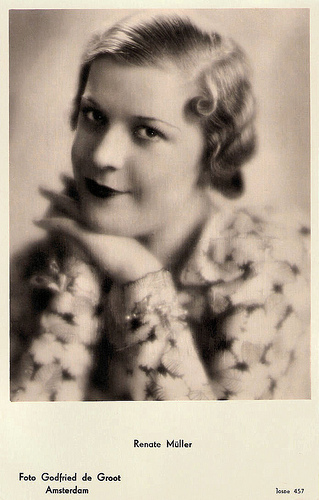
Dutch postcard by JosPe, no. 457. Photo: Godfried de Groot, Amsterdam.
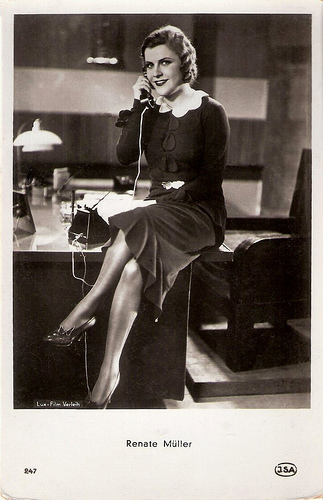
Dutch postcard by J.S.A., no. 247. Photo: Lux-Film Verleih. Still from Die Privatsekretärin/Private Secretary (Wilhelm Thiele, 1931).
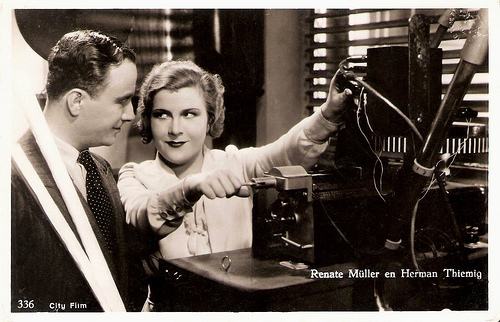
Dutch postcard by JosPe, no. 336. Photo: City Film. Publicity still from Die Privatsekretärin/The Private Secretary (Wilhelm Thiele, 1931) with Hermann Thimig .
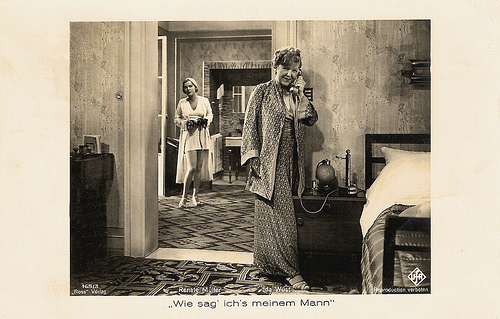
German postcard by Ross Verlag, no. 165/3, 1932-1933. Photo: Ufa. Publicity still for Wie sag' ich's meinem Mann?/How Shall I Tell My Husband? (Reinhold Schünzel, 1932) with Ida Wüst .
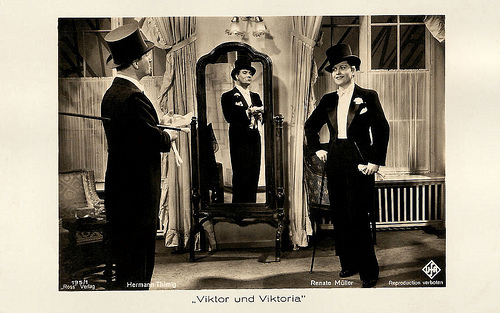
German postcard by Ross Verlag, no. 195/1. Photo: Ufa. Publicity still for Viktor und Viktoria/Viktor and Viktoria (Reinhold Schünzel, 1933) with Hermann Thimig .
Reinhold Schünzel
Reinhold Schünzel directed Renate Müller in 8 of her 26 films. He is one of the most badly neglected directors of the German pre-war cinema. This is probably caused by the fact that he received the status of an 'Ehrenarier' during the Third Reich.
Schünzel gave valuable impulses for the German cinema. He was successful as an actor as well as a director, writer and producer. Already in 1918 he directed his first film.
Schünzel developed into a crowd-puller in the sound film era with comedies like Saison in Kairo/Cairo Season (1933), Viktor und Viktoria (1933) and Die englische Heirat/The English Marriage (1934), all starring Renate Müller.
Viktor und Viktoria (1933) with Müller as a female vaudeville artist dressing up as a man, was the highlight. It is even wittier than the famous Julie Andrews version, Victor Victoria (Blake Andrews, 1981).
But work became more and more difficult for Schünzel because of the Third Reich, and as a half-Jew he depended on a work permit for each further film. His success protected him, and in 1935 he shot the most successful film of the year - Amphytrion starring Willy Fritsch .
But already in 1937 there were so many interventions in his films that he left the country for the USA directly after finishing Land der Liebe/Land of Love (1937).
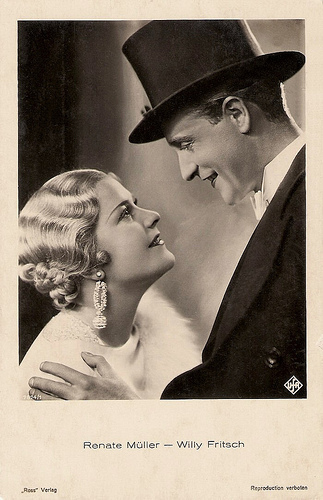
German postcard by Ross Verlag, no. 7874/1, 1932-1933. Photo: Ufa. Publicity still for Saison in Kairo/Cairo Season (Reinhold Schünze, 1933l), starring Renate Müller and Willy Fritsch .
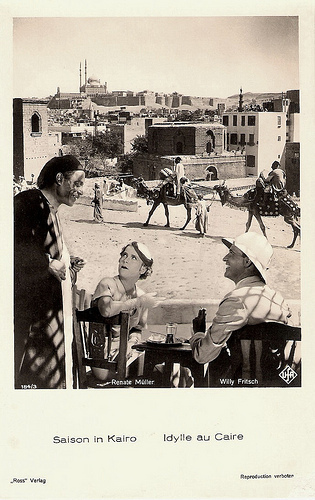
German postcard by Ross Verlag, no. 104/3. Photo: Ufa. Still from Saison in Kairo/Cairo Season (1933).
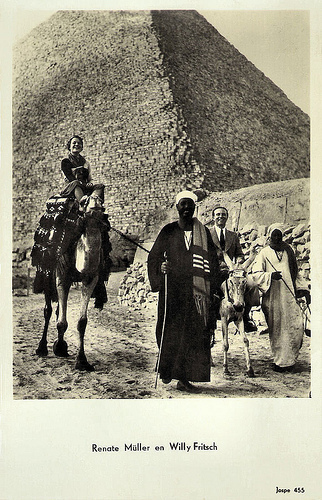
Dutch postcard by JosPe, no. 455. Photo: publicity still for the musical comedy Saison in Cairo/Season in Cairo (Reinhold Schünzel, 1933).
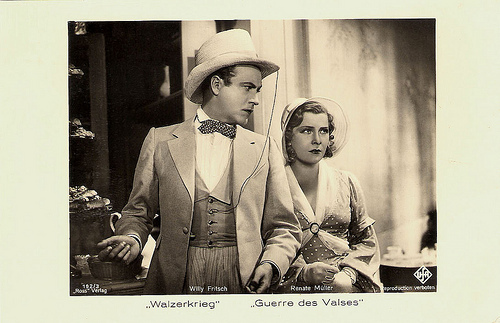
German postcard by Ross Verlag, no. 192/3, 1932-1933. Photo: Ufa. Publicity still for Walzerkrieg/Waltz Time in Vienna (Ludwig Berger, 1933) with Willy Fritsch . Collection: Egbert Barten.
The True Circumstances
With the rise of the Nazi Party, Renate Müller came to be regarded as an ideal Aryan woman and particularly in the light of Marlene Dietrich 's move to Hollywood, she was courted and promoted as Germany's leading film actress.
According to Wikipedia , a meeting with Adolf Hitler resulted in Müller being offered parts in films that promoted Nazi ideals.
After a breakdown in 1933, she had to stop filming in 1934 because of a serious disease, probably epilepsy. Afterwards she only did sporadic performances. Wikipedia notes that she was also known to have been pressured to end a relationship with her Jewish lover, but had refused.
Hans J. Wollstein writes at AllMovie that she finally gave in to the pressure of the Nazis, starring in the blatantly anti-Semitic Togger (1937). The situation made her a nervous wreck and in October 1937 she checked into a clinic, ostensibly for treatment of a knee injury. She never returned.
When she suddenly died on 10 October 1937, the German press stated the cause as epilepsy, but witnesses recalled seeing several Gestapo officers entering her building shortly before she died.
Her death proved a public relations disaster for the regime in general and for propaganda minister Goebbels in particular. To counteract the public's negative reactions, the ministry of propaganda spread rumors that she had become addicted to morphine, that she was an alcoholic and mentally disturbed.
Her life story later was filmed as Liebling der Götter/Darling of the Gods (Gottfried Reinhardt, 1960), with Ruth Leuwerik playing Renate.
According to the British TV documentary Sex and the Swastika (2009), Renate jumped from a window in the Berlin mental home. Wikipedia states that it has been asserted she was either murdered by Gestapo officers who threw her from a window, or that she panicked when she saw them arrive and jumped. The true circumstances surrounding her death remain unclear.
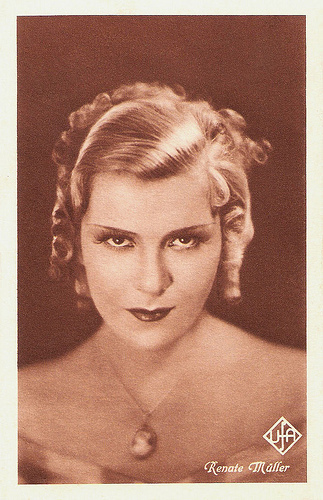
Dutch postcard, for the Dutch release of Walzerkrieg/The Battle of the Walzes (Ludwig Berger, 1933). Photo: Ufa.
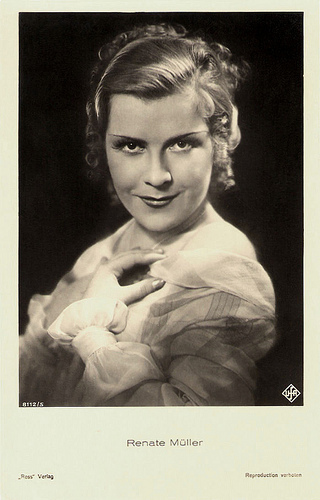
German postcard by Ross Verlag, no. 8112/3, 1933-1934. Photo: Ufa.
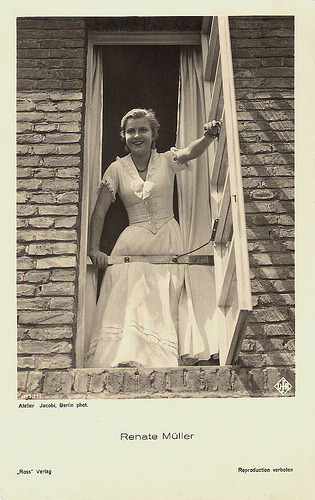
German postcard by Ross Verlag, no. 8113/1, 1933-1934. Photo: Ufa / Atelier Jacobi, Berlin.
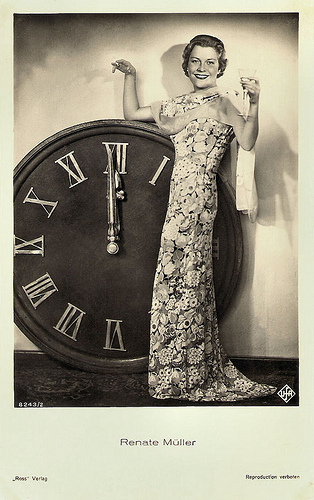
German postcard by Ross Verlag, no. 8243/2, 1933-1934. Photo: Ufa.
Renate Müller sings Today I Feel so happy in Sunshine Susie (1932). Source: Alparfan (YouTube).
Sources: Hans J. Wollstein (AllMovie), Thomas Staedeli (Cyranos), Filmportal.de, Wikipedia and .

German postcard by Ross Verlag, no. 7867/1, 1932-1933. Photo: Ufa.
 German postcard by Ross Verlag, no. 7868/1, 1932-1933. Photo: Ufa
German postcard by Ross Verlag, no. 7868/1, 1932-1933. Photo: Ufa
German postcard by Ross Verlag, no. 8751/2, 1933-1934. Photo: Atelier Schenker, Berlin.
Well-Trained Voice
Renate Müller was born in Munich, Germany, in 1906. Her father was one of Munich's leading newspaper publishers.
She was trained as a singer and a stage actress at the Max Reinhardt theatre school. Famous director G.W. Pabst reportedly gave her lessons there.
She started acting on stage in the second half of the 1920's, at the Berlin Lessing Theater, and played opposite famous actor Alexander Moissi on-stage in Zweimal Oliver/Oliver Twice.
A blue-eyed blonde, she was considered to be one of the great beauties of her day. Director Reinhold Schünzel let her make her film debut with the comedy Peter, der Matrose/Peter the Sailor (1929).
That was still a silent film, but Müller would soon flourish in the German sound film, for which her well-trained voice came in handy. She played in the German version of Italy's first sound film, Gennaro Righelli's La canzone dell'amore, Liebeslied/Love Song (Constantin J. David, 1931) with Gustav Fröhlich .

German postcard by Ross Verlag, no. 745. Photo: Godfried de Groot, Amsterdam.

German postcard by Ross Verlag, no. 6450/1, 1931-1932.

German postcard by Ross Verlag, no. 7278/3, 1932-1933. Photo: Ufa.

German postcard by Ross Verlag, no. 8113/1, 1933-1934. Photo: Ufa / Atelier Jacobi, Berlin.

Austrian postcard by Iris Verlag / Amag, no. 6497. Photo: Felsom-Film / Kiba-Verleih.
Natural and Self-conscious Woman
Renate Müller played often the natural, self-conscious young woman who knows what she wants, opposing the sweet girls and vamps of the 1920s. And thus we see her in films such as the singing secretary in Die Privatsekretärin/Private Secretary (Wilhelm Thiele, 1931), of which her song Ich bin ja heut' so glücklich became a smash hit.
In the simultaneously made English version, Sunshine Susie (Victor Saville, 1932), Müller also starred, and now she sang Today I am so happy.
There were also a French version, Dactylo, with Marie Glory , and an Italian version, La segretaria privata, with Elsa Merlini who sang Oh come son' felice, felice, felice.
At AllMovie , Hans J. Wollstein writes: "The ultimately tragic Renate Müller blazed onto international screens in Die Privatesekretärin (The Private Secretary, 1931), a sort of Germanic Joan Crawford getting by in a man's world on her wits and a pair of shapely legs. The comedy was so popular that Müller also made an English-language version featuring popular U.K. star Owen Nares ."

Dutch postcard by JosPe, no. 457. Photo: Godfried de Groot, Amsterdam.

Dutch postcard by J.S.A., no. 247. Photo: Lux-Film Verleih. Still from Die Privatsekretärin/Private Secretary (Wilhelm Thiele, 1931).

Dutch postcard by JosPe, no. 336. Photo: City Film. Publicity still from Die Privatsekretärin/The Private Secretary (Wilhelm Thiele, 1931) with Hermann Thimig .

German postcard by Ross Verlag, no. 165/3, 1932-1933. Photo: Ufa. Publicity still for Wie sag' ich's meinem Mann?/How Shall I Tell My Husband? (Reinhold Schünzel, 1932) with Ida Wüst .

German postcard by Ross Verlag, no. 195/1. Photo: Ufa. Publicity still for Viktor und Viktoria/Viktor and Viktoria (Reinhold Schünzel, 1933) with Hermann Thimig .
Reinhold Schünzel
Reinhold Schünzel directed Renate Müller in 8 of her 26 films. He is one of the most badly neglected directors of the German pre-war cinema. This is probably caused by the fact that he received the status of an 'Ehrenarier' during the Third Reich.
Schünzel gave valuable impulses for the German cinema. He was successful as an actor as well as a director, writer and producer. Already in 1918 he directed his first film.
Schünzel developed into a crowd-puller in the sound film era with comedies like Saison in Kairo/Cairo Season (1933), Viktor und Viktoria (1933) and Die englische Heirat/The English Marriage (1934), all starring Renate Müller.
Viktor und Viktoria (1933) with Müller as a female vaudeville artist dressing up as a man, was the highlight. It is even wittier than the famous Julie Andrews version, Victor Victoria (Blake Andrews, 1981).
But work became more and more difficult for Schünzel because of the Third Reich, and as a half-Jew he depended on a work permit for each further film. His success protected him, and in 1935 he shot the most successful film of the year - Amphytrion starring Willy Fritsch .
But already in 1937 there were so many interventions in his films that he left the country for the USA directly after finishing Land der Liebe/Land of Love (1937).

German postcard by Ross Verlag, no. 7874/1, 1932-1933. Photo: Ufa. Publicity still for Saison in Kairo/Cairo Season (Reinhold Schünze, 1933l), starring Renate Müller and Willy Fritsch .

German postcard by Ross Verlag, no. 104/3. Photo: Ufa. Still from Saison in Kairo/Cairo Season (1933).

Dutch postcard by JosPe, no. 455. Photo: publicity still for the musical comedy Saison in Cairo/Season in Cairo (Reinhold Schünzel, 1933).

German postcard by Ross Verlag, no. 192/3, 1932-1933. Photo: Ufa. Publicity still for Walzerkrieg/Waltz Time in Vienna (Ludwig Berger, 1933) with Willy Fritsch . Collection: Egbert Barten.
The True Circumstances
With the rise of the Nazi Party, Renate Müller came to be regarded as an ideal Aryan woman and particularly in the light of Marlene Dietrich 's move to Hollywood, she was courted and promoted as Germany's leading film actress.
According to Wikipedia , a meeting with Adolf Hitler resulted in Müller being offered parts in films that promoted Nazi ideals.
After a breakdown in 1933, she had to stop filming in 1934 because of a serious disease, probably epilepsy. Afterwards she only did sporadic performances. Wikipedia notes that she was also known to have been pressured to end a relationship with her Jewish lover, but had refused.
Hans J. Wollstein writes at AllMovie that she finally gave in to the pressure of the Nazis, starring in the blatantly anti-Semitic Togger (1937). The situation made her a nervous wreck and in October 1937 she checked into a clinic, ostensibly for treatment of a knee injury. She never returned.
When she suddenly died on 10 October 1937, the German press stated the cause as epilepsy, but witnesses recalled seeing several Gestapo officers entering her building shortly before she died.
Her death proved a public relations disaster for the regime in general and for propaganda minister Goebbels in particular. To counteract the public's negative reactions, the ministry of propaganda spread rumors that she had become addicted to morphine, that she was an alcoholic and mentally disturbed.
Her life story later was filmed as Liebling der Götter/Darling of the Gods (Gottfried Reinhardt, 1960), with Ruth Leuwerik playing Renate.
According to the British TV documentary Sex and the Swastika (2009), Renate jumped from a window in the Berlin mental home. Wikipedia states that it has been asserted she was either murdered by Gestapo officers who threw her from a window, or that she panicked when she saw them arrive and jumped. The true circumstances surrounding her death remain unclear.

Dutch postcard, for the Dutch release of Walzerkrieg/The Battle of the Walzes (Ludwig Berger, 1933). Photo: Ufa.

German postcard by Ross Verlag, no. 8112/3, 1933-1934. Photo: Ufa.

German postcard by Ross Verlag, no. 8113/1, 1933-1934. Photo: Ufa / Atelier Jacobi, Berlin.

German postcard by Ross Verlag, no. 8243/2, 1933-1934. Photo: Ufa.
Renate Müller sings Today I Feel so happy in Sunshine Susie (1932). Source: Alparfan (YouTube).
Sources: Hans J. Wollstein (AllMovie), Thomas Staedeli (Cyranos), Filmportal.de, Wikipedia and .
Published on April 29, 2014 23:00
April 28, 2014
Paul Heidemann
German stage and screen actor Paul Heidemann (1884-1968) was also a film director and producer. In the silent period, he was famous for his character Teddy and his other comical parts. He also played many supporting roles in sound comedies.
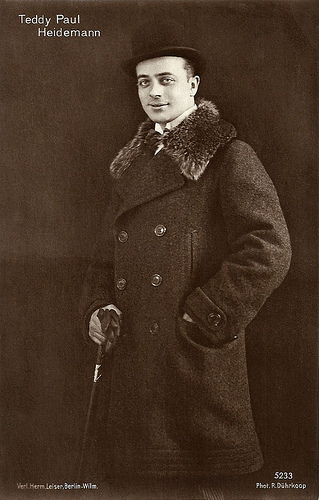
German postcard by Verlag Hermann Leiser, Berlin-Wilm., no. 5233. Photo: R. Dührkoop.

German postcard by Photochemie, no. K. 157. Photo: Alex Binder, Berlin.
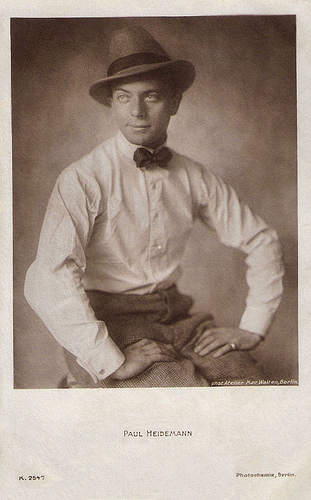
German postcard by Photochemie, Berlin, no. K. 2547. Photo: Atelier Mac Walten, Berlin.
Talented Comedian
Paul Heidemann was born in Cologne, Germany in 1884. After an initial career in the tobacco branch, he took acting lessons from the Meiningen based court actor Leopold Teller.
In 1906 he debuted in Hanau as Prince Karl-Heinz in the operetta Alt-Heidelberg (Old Heidelberg). In 1909, he joined the theatre of Breslau, where he sang in Bruno Granichstaedten’s operetta Bub oder Mädel (Boy or Girl). Here Heidemann created his reputation as talented comedian.
On the recommendation of composer Jean Gilbert, he moved to Berlin in 1911, where he debuted in Gilbert’s play Die keusche Susanne (The chaste Susanne).
Franz Porten discovered Heidemann for the cinema, where he played his first lead in Das Brandmal ihrer Vergangenheit/The stigma of her past (1912). It was followed by films such as Das Teufelsloch/The Devil's Hole (Rudolf Del Zopp, 1913), and Vater und Sohn/Father and Son (Afred Halm, 1914) with Leopoldine Konstantin.
From 1913 to 1915 he also played the character Teddy in countless comical shorts, such as Teddy ist herzkrank/Teddy has a heart condition (1914), Teddys Geburtstagsgeschenk/Teddy's Birthday Present (1915) and Teddy züchtet Notkartoffeln/teddy breeds emergency potatoes (1915). Sometimes he directed these films as well.
Between 1919 and 1923 Heidemann had his own production company, Paul Heidemann-Film GmbH in Berlin, where he played the lead in films initially mostly directed by Erich Schönefelder and later on rather by Georg Schubert or by Heidemann himself. A late example is Eine kleine Freundin braucht ein jeder Mann/Every man Needs A little Friend (Paul Heidemann, 1927), starring Heidemann but also Julius Falkenstein, Hans Albers , Siegfried Arno and Charlotte Ander .
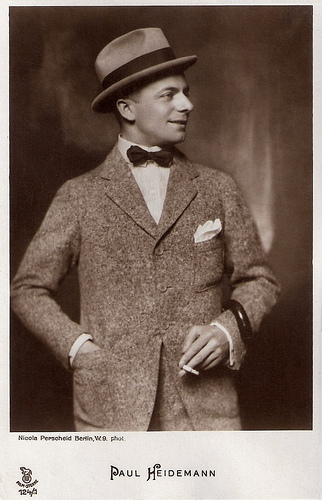
German postcard by Rotophot in the Film Sterne series, no. 124/1. Photo: Nicola Perscheid, Berlin.
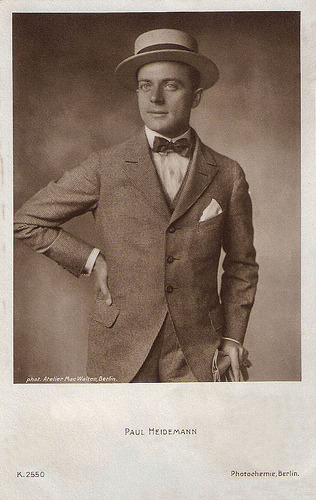
German postcard by Photochemie, Berlin, no. K. 2550. Photo: Atelier Mac Walten, Berlin.
Military Comedies
In the 1920s, Paul Heidemann became an important supporting actor and sometimes leading man in all kinds of films.
He had a supporting part in the silent comedy classic Die Bergkatze/The Wild Cat (Ernst Lubitsch, 1921) featuring Pola Negri as a wild mountain girl and bandit’s daughter.
Heidemann played the lead in the silent historical comedy Der kleine Napoleon/The Little Napoleon (Georg Jacoby, 1923). It depicts the life and amorous adventures of Jérôme Bonaparte, the younger brother of Napoleon (Egon von Hagen), who installed him as King of Westphalia. The film also marked Marlene Dietrich 's film debut and was made by the European Film Alliance, a failed attempt by the American studio Paramount to establish a production base in the lucrative German market. The EFA was wound up shortly after the film's completion, which delayed its release. It finally premièred on 29 November 1923 at the legendary Berlin movie palace Marmorhaus.
He often played in comedies, such Der Sprung ins Leben/Leap Into Life (Johannes Guter, 1923) with Xenia Desni , Das süsse Mädel/The Sweet Girl (Manfred Noa, 1926) with Mary Nolan and Mary Parker , Die dritte Eskadron/The Third Squadron (Carl Wilhelm, 1926) with Claire Rommer , Flucht aus der Hölle/Escape from Hell (Georg Asagaroff, 1928) with Heidemann, Jean Murat and Agnes Esterhazy , and Flucht vor der Liebe/The flight from love (Hans Behrendt, 1930) with Jenny Jugo and Enrico Benfer .
Heidemann acted often as sidekick of the popular actor Hans Albers , such as in Der lachende Ehemann/The Laughing Husband (Rudolf Walther-Fein, Rudolf Dworsky, 1926) and the crime drama Hans in allen Gassen/Hans of all trades (Carl Froelich, 1930).
Other silent films, in which Heidemann played supporting parts were the drama Die Geliebte/The Mistress (Robert Wiene, 1927) with Harry Liedtke , and Unter der Laterne/Under the Lantern (Gerhard Lamprecht, 1928) starring Lissi Arna . And he played the lead in the silent drama Der Zigeunerprimas/The Gypsy Chief (Carl Wilhelm, 1929).
Simultaneously Heidemann acted on the Berlin stages, mainly in operettas.
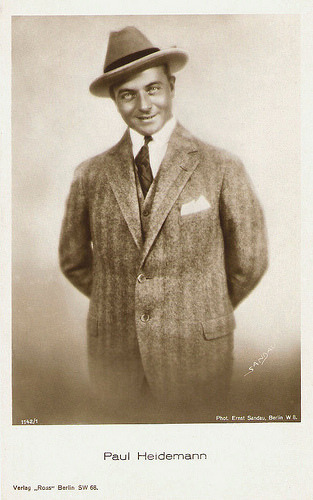
German postcard by Ross Verlag, Berlin, no. 1142/1, 1927-1928. Photo: Ernst Sandau, Berlin.
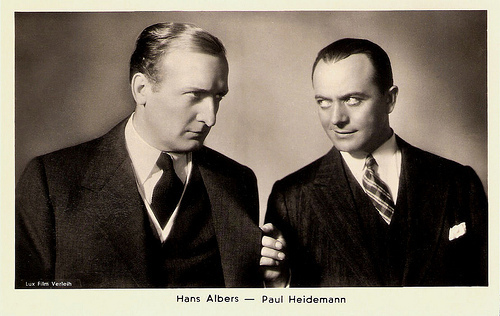
With Hans Albers Austrian Postcard by Iris Verlag, no. 6699. Photo: Lux Film Verleih.
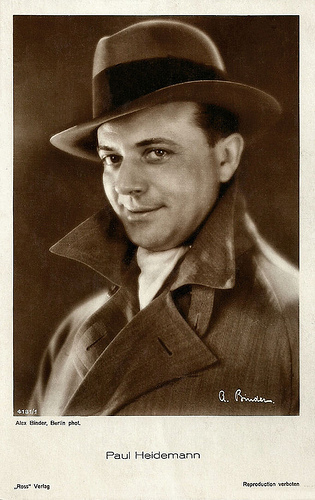
German postcard by Ross Verlag, no. 4181/1, 1929-1930. Photo: Alex Binder, Berlin.
Sidekick
After the introduction of sound film, Paul Heidemann continued to appear in supporting parts in many German films. An example is the comedy Pension Schöller (Georg Jacoby, 1930) starring Paul Henckels and Elga Brink. It is an adaptation of the 1890 play Pension Schöller by Wilhelm Jacoby and Carl Laufs. Georg Jacoby was Wilhelm's son, and made three film adaptation of his father's best known play in 1930, 1952 and 1960.
Heidemann played the following year in the romantic comedy Ihre Hoheit befiehlt/Her Grace Commands (Hanns Schwarz, 1931) about a hairdresser ( Käthe von Nagy ) and a greengrocer ( Willy Fritsch ) who fall in love and conceal from each other the truth that they are really a Princess and an army officer in disguise.
When in the early 1930s military comedies were popular, Heidemann acted in various military farces such as Wenn die Soldaten.../When the soldiers... (Luise & Jakob Fleck, 1931) with Otto Walburg , Schön ist die Manöverzeit/Manoeuver Time Is Fine (Erich Schönfelder, 1931) with Ida Wüst , Die Mutter der Kompanie/The Company's Mother (Franz Seitz senior, 1931), Drei von der Kavallerie/Number Three Cavalryman (Carl Boese, 1932) with Paul Hörbiger and Fritz Kampers, and Liebe in Uniform/Love in Uniform (Georg Jacoby, 1932).
Among his most well-known productions are Der tolle Bomberg/The Mad Bomberg (Georg Asagaroff, 1932) with Heidemann in the lead, Ganovenehre/Crook's Honour (Richard Oswald, 1932) with Fritz Kampers, Paprika (1932, Carl Boese) with Franciska Gaál , Narren im Schnee/Fools in the snow (Hans Deppe, 1939) with Anny Ondra , and Schneider Wibbel/Tailor Wibbel ( Viktor de Kowa , 1939) with Erich Ponto.
During the Second World War, Heidemann worked again as film director. He staged film comedies, such as Mein Mann darf es nicht wissen/My husband must not know (1940) with Mady Rahl , Krach im Vorderhaus/Noise in the front house (1941) again with Rahl, Weisse Wäsche/White laundry (1942) with Harald Paulsen , and Floh im Ohr/Flea in Her Ear (1943), even if the films were not huge hits.
In the 1950s, he acted both in BRD and DDR films. In East-Germany he played Presskopp in the old Berlin farce Ein Polterabend/A stag night (Curt Bois, 1955) and the mayor in Bärenburger Schnurre/Bärenburg Farce (Ralf Kirsten, 1957).
He also acted in West-German films like Torreani ( Gustav Fröhlich , 1951), Der keusche Josef/The chaste Joseph (Carl Boese, 1953), Rittmeister Wronski/Cavalry Captain Wronski (Ulrich Erfurth, 1954), Der Mustergatte/The Model Husband (Erik Ode, 1956) and Jede Nacht in einem anderen Bett/Every night in a different bed (Paul Verhoeven, 1957).
Paul Heidemann died in Berlin in 1968. He was 83.
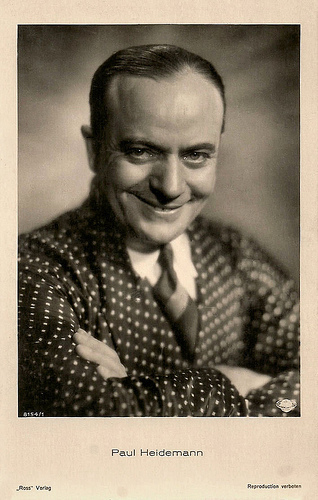
German postcard by Ross Verlag, no. 8154/1, 1933-1934.
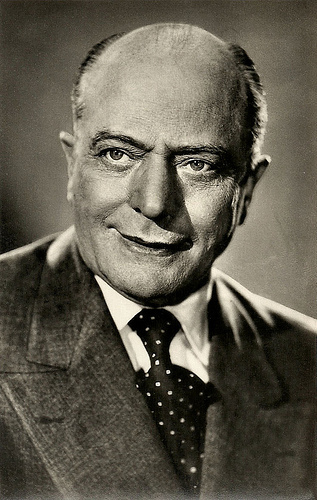
East-German postcard by VEB-Progress Film-Vertrieb, Berlin, no. 176-59. Photo: Defa-Neufeld. Publicity still for Junges Gemüse/Young Vegetables (Günter Reisch, 1956).
Sources: Thomas Staedeli (Cyranos), Volker Wachter (Defa Sternstunden) (German), Filmportal.de, Wikipedia (German) and .

German postcard by Verlag Hermann Leiser, Berlin-Wilm., no. 5233. Photo: R. Dührkoop.

German postcard by Photochemie, no. K. 157. Photo: Alex Binder, Berlin.

German postcard by Photochemie, Berlin, no. K. 2547. Photo: Atelier Mac Walten, Berlin.
Talented Comedian
Paul Heidemann was born in Cologne, Germany in 1884. After an initial career in the tobacco branch, he took acting lessons from the Meiningen based court actor Leopold Teller.
In 1906 he debuted in Hanau as Prince Karl-Heinz in the operetta Alt-Heidelberg (Old Heidelberg). In 1909, he joined the theatre of Breslau, where he sang in Bruno Granichstaedten’s operetta Bub oder Mädel (Boy or Girl). Here Heidemann created his reputation as talented comedian.
On the recommendation of composer Jean Gilbert, he moved to Berlin in 1911, where he debuted in Gilbert’s play Die keusche Susanne (The chaste Susanne).
Franz Porten discovered Heidemann for the cinema, where he played his first lead in Das Brandmal ihrer Vergangenheit/The stigma of her past (1912). It was followed by films such as Das Teufelsloch/The Devil's Hole (Rudolf Del Zopp, 1913), and Vater und Sohn/Father and Son (Afred Halm, 1914) with Leopoldine Konstantin.
From 1913 to 1915 he also played the character Teddy in countless comical shorts, such as Teddy ist herzkrank/Teddy has a heart condition (1914), Teddys Geburtstagsgeschenk/Teddy's Birthday Present (1915) and Teddy züchtet Notkartoffeln/teddy breeds emergency potatoes (1915). Sometimes he directed these films as well.
Between 1919 and 1923 Heidemann had his own production company, Paul Heidemann-Film GmbH in Berlin, where he played the lead in films initially mostly directed by Erich Schönefelder and later on rather by Georg Schubert or by Heidemann himself. A late example is Eine kleine Freundin braucht ein jeder Mann/Every man Needs A little Friend (Paul Heidemann, 1927), starring Heidemann but also Julius Falkenstein, Hans Albers , Siegfried Arno and Charlotte Ander .

German postcard by Rotophot in the Film Sterne series, no. 124/1. Photo: Nicola Perscheid, Berlin.

German postcard by Photochemie, Berlin, no. K. 2550. Photo: Atelier Mac Walten, Berlin.
Military Comedies
In the 1920s, Paul Heidemann became an important supporting actor and sometimes leading man in all kinds of films.
He had a supporting part in the silent comedy classic Die Bergkatze/The Wild Cat (Ernst Lubitsch, 1921) featuring Pola Negri as a wild mountain girl and bandit’s daughter.
Heidemann played the lead in the silent historical comedy Der kleine Napoleon/The Little Napoleon (Georg Jacoby, 1923). It depicts the life and amorous adventures of Jérôme Bonaparte, the younger brother of Napoleon (Egon von Hagen), who installed him as King of Westphalia. The film also marked Marlene Dietrich 's film debut and was made by the European Film Alliance, a failed attempt by the American studio Paramount to establish a production base in the lucrative German market. The EFA was wound up shortly after the film's completion, which delayed its release. It finally premièred on 29 November 1923 at the legendary Berlin movie palace Marmorhaus.
He often played in comedies, such Der Sprung ins Leben/Leap Into Life (Johannes Guter, 1923) with Xenia Desni , Das süsse Mädel/The Sweet Girl (Manfred Noa, 1926) with Mary Nolan and Mary Parker , Die dritte Eskadron/The Third Squadron (Carl Wilhelm, 1926) with Claire Rommer , Flucht aus der Hölle/Escape from Hell (Georg Asagaroff, 1928) with Heidemann, Jean Murat and Agnes Esterhazy , and Flucht vor der Liebe/The flight from love (Hans Behrendt, 1930) with Jenny Jugo and Enrico Benfer .
Heidemann acted often as sidekick of the popular actor Hans Albers , such as in Der lachende Ehemann/The Laughing Husband (Rudolf Walther-Fein, Rudolf Dworsky, 1926) and the crime drama Hans in allen Gassen/Hans of all trades (Carl Froelich, 1930).
Other silent films, in which Heidemann played supporting parts were the drama Die Geliebte/The Mistress (Robert Wiene, 1927) with Harry Liedtke , and Unter der Laterne/Under the Lantern (Gerhard Lamprecht, 1928) starring Lissi Arna . And he played the lead in the silent drama Der Zigeunerprimas/The Gypsy Chief (Carl Wilhelm, 1929).
Simultaneously Heidemann acted on the Berlin stages, mainly in operettas.

German postcard by Ross Verlag, Berlin, no. 1142/1, 1927-1928. Photo: Ernst Sandau, Berlin.

With Hans Albers Austrian Postcard by Iris Verlag, no. 6699. Photo: Lux Film Verleih.

German postcard by Ross Verlag, no. 4181/1, 1929-1930. Photo: Alex Binder, Berlin.
Sidekick
After the introduction of sound film, Paul Heidemann continued to appear in supporting parts in many German films. An example is the comedy Pension Schöller (Georg Jacoby, 1930) starring Paul Henckels and Elga Brink. It is an adaptation of the 1890 play Pension Schöller by Wilhelm Jacoby and Carl Laufs. Georg Jacoby was Wilhelm's son, and made three film adaptation of his father's best known play in 1930, 1952 and 1960.
Heidemann played the following year in the romantic comedy Ihre Hoheit befiehlt/Her Grace Commands (Hanns Schwarz, 1931) about a hairdresser ( Käthe von Nagy ) and a greengrocer ( Willy Fritsch ) who fall in love and conceal from each other the truth that they are really a Princess and an army officer in disguise.
When in the early 1930s military comedies were popular, Heidemann acted in various military farces such as Wenn die Soldaten.../When the soldiers... (Luise & Jakob Fleck, 1931) with Otto Walburg , Schön ist die Manöverzeit/Manoeuver Time Is Fine (Erich Schönfelder, 1931) with Ida Wüst , Die Mutter der Kompanie/The Company's Mother (Franz Seitz senior, 1931), Drei von der Kavallerie/Number Three Cavalryman (Carl Boese, 1932) with Paul Hörbiger and Fritz Kampers, and Liebe in Uniform/Love in Uniform (Georg Jacoby, 1932).
Among his most well-known productions are Der tolle Bomberg/The Mad Bomberg (Georg Asagaroff, 1932) with Heidemann in the lead, Ganovenehre/Crook's Honour (Richard Oswald, 1932) with Fritz Kampers, Paprika (1932, Carl Boese) with Franciska Gaál , Narren im Schnee/Fools in the snow (Hans Deppe, 1939) with Anny Ondra , and Schneider Wibbel/Tailor Wibbel ( Viktor de Kowa , 1939) with Erich Ponto.
During the Second World War, Heidemann worked again as film director. He staged film comedies, such as Mein Mann darf es nicht wissen/My husband must not know (1940) with Mady Rahl , Krach im Vorderhaus/Noise in the front house (1941) again with Rahl, Weisse Wäsche/White laundry (1942) with Harald Paulsen , and Floh im Ohr/Flea in Her Ear (1943), even if the films were not huge hits.
In the 1950s, he acted both in BRD and DDR films. In East-Germany he played Presskopp in the old Berlin farce Ein Polterabend/A stag night (Curt Bois, 1955) and the mayor in Bärenburger Schnurre/Bärenburg Farce (Ralf Kirsten, 1957).
He also acted in West-German films like Torreani ( Gustav Fröhlich , 1951), Der keusche Josef/The chaste Joseph (Carl Boese, 1953), Rittmeister Wronski/Cavalry Captain Wronski (Ulrich Erfurth, 1954), Der Mustergatte/The Model Husband (Erik Ode, 1956) and Jede Nacht in einem anderen Bett/Every night in a different bed (Paul Verhoeven, 1957).
Paul Heidemann died in Berlin in 1968. He was 83.

German postcard by Ross Verlag, no. 8154/1, 1933-1934.

East-German postcard by VEB-Progress Film-Vertrieb, Berlin, no. 176-59. Photo: Defa-Neufeld. Publicity still for Junges Gemüse/Young Vegetables (Günter Reisch, 1956).
Sources: Thomas Staedeli (Cyranos), Volker Wachter (Defa Sternstunden) (German), Filmportal.de, Wikipedia (German) and .
Published on April 28, 2014 23:00
April 27, 2014
Toni Sailer
Charismatic multitalent Toni Sailer (1935-2009) was a legendary Austrian alpine ski racer, one of the best the sport has ever produced. The ‘Black Blitz from Kitz’ appeared as an actor and singer in several films and TV series. He was a national hero and matinee idol rolled into one.
Austrian postcard by Kellner-Fotokarten, Wien, no 1335. Photo: Bavaria / Schorcht / Ringpress / Vogelmann.
German postcard by Ufa, Berlin-Tempelhof, no. CK-314. Photo: Arthur Grimm / Ufa.
Handsome and dashing
Anton Engelbert ‘Toni’ Sailer (pronounced SIGH-ler) was born in Kitzbühel, in the Tyrolean Alps, in 1935. He was skiing since he was 2 years old. The son of a glass shop owner, he became a licensed glazier and plumber and worked in the shop except in winter, when he trained four hours a day.
His first skiing victory came when he was 11. The prize was two sausages. Skiing ran through Sailer’s family. His younger brother, Rudi, later ran Sailer’s ski school. Their uncle Sepp was a ski instructor for 55 years.
Barely out of his teens, he became the first skier at the Winter Olympics to win all three alpine skiing events at the 1956 Winter Olympics in Cortina d'Ampezzo, Italy. He took gold in the downhill, slalom, and giant slalom, and won them all by large margins. He was just the fifth athlete to win three gold medals in the same Olympic games.
Handsome and dashing, he was quickly nicknamed the ‘Black Blitz from Kitz’ (because of his hometown and the black suits he often wore). Sailer was a multitalent and a thinker, who always tried to improve his skiing technique. He was a huge youth idol and Sailer’s Olympic fame was credited with bringing publicity and tourism to Kitzbühel.
In gratitude, town officials gave him land. He built a hotel there. Two years later, he won three gold medals and one silver at the four-event 1958 World Championships in Bad Gastein, Austria. Sailer was named Austrian Sportspersonality of the year in 1956, 1957, and 1958, and Austrian Sportspersonality of the Century in 1999.
German photo by Kolibri-Verlag G.m.b.H., Minden/Westf., no. 290. Photo: Bavaria-Filmverl. Still from Der Schwarze Blitz (1958).
German postcard by Ufa (Universum-Film Aktiengesellschaft), Berlin-Tempelhof, no. FK 4200. Retail price: 25 Pfg. Photo: Bavaria. Still from Der schwarze Blitz/The Black Blitz (1958).
German postcard by Franz Josef Rudel Filmpostkartenverlag, Hamburg-Bergedorf, no. D 2441. Photo: Bavaria. Still from Der schwarze Blitz/The Black Blitz (1958).
The Black Blitz
Toni Sailer retired from competition in 1959, because he couldn’t combine his commercial activities with his amateur status as a ski-champion.
From 1958 till 1971, he appeared in some 20 dozen of films. He followed acting classes at the film school in Berlin. His film debut was the romance Ein Stück vom Himmel/A Piece of Heaven (Rudolf Jugert, 1958) with Ingrid Andree .
In the Heimatfilm Der schwarze Blitz/The Black Blitz (Hans Grimm, 1958) he played a skier who is accused of stealing his rival's wax and causing his rival's training injuries by moving one of the gates on the downhill race course.
In the following years he played in a series of shallow comedies at least partly set in alpine regions, including Tausend Sterne leuchten/A Thousand Stars Aglitter (Harald Philipp, 1959) with Germaine Damar , and Ein Stern fällt vom Himmel/A Star Falls from Heaven (Géza von Cziffra, 1961) with Ina Bauer.
On stage he played the lead in Death of a Salesman, the classic play by Arthur Miller. He also performed as a Schlager singer and he released 18 popular records. Some of his songs were even hits in Japan, where he also made a film.
In Italy he appeared in the western Sansone e il tesoro degli Incas/Lost Treasure of the Incas (Piero Pierotti, 1964). In the TV film Das Blaue vom Himmel/The Blue from the Sky (Wolfgang Schleif, 1964) he co-starred with the legendary Ufa star Zarah Leander .
Most of his films were mere showcases for his ski talent, but Ski Fever (Curt Siodmak, 1966), co-starring Claudia Martin, daughter of Dean Martin, was miraculously nominated for a Golden Globe.
German postcard by Kunst und Bild, Berlin-Charlottenburg, no. B 1548. Photo: Centfox.

German postcard by WS-Druck, Wanna-Eickel, no. F 102. Photo: Klaus Collignon.
German postcard by Kunst und Bild, Berlin-Charlottenburg, no. S 765. Photo: Bavaria/Schorcht/Vogelmann. Still from Ein Stück vom Himmel/A Piece of Heaven (1958).
German postcard by Ufa (Universum-Film Aktiengesellschaft), Berlin-Tempelhof, no. FK 4716. Retail price 25 Pfg. Photo: Grimm.
There Where the Hills Are
In 1965, Toni Sailer retired from the film and show business and moved to Canada.
Some years later he returned to Austria and started the clothing firm Sailer Sports. He ran a well-known ski school for children and served as an international skiing official.
From 1972 till 1976, he was chief trainer and technical director of the Austrian Skiing Association (ÖSV), which produced champion skiers like Franz Klammer and Annemarie Moser-Pröll. For his contribution to the Olympic Movement, the International Olympic Committee awarded him the Olympic Order in 1985.
Occasionally, he was noted for appearing in TV series like Die Leute von St. Benedikt/The People of Saint Benedikt (1992) or such made for TV films as Da wo die Berge sind/There Where the Hills Are (Kurt Ockermueller, 2000).
His last appearance for the camera was in the popular TV series SOKO Kitzbühel (2003). In 2004, he announced this candidacy for Mayor of his hometown Kitzbühel, but he withdrew some weeks later, claiming he had not expected it to be a fulltime job.
Toni Sailer married Gaby Rummeny in 1976 in Vancouver; she died of cancer in 2000. His second marriage, to Hedwig Fischer, lasted from 2006 until his death.
It was announced in January 2008 that Toni Sailer had laryngeal cancer, for which he had been undergoing chemotheraphy in the preceding months. He died of cancer in Innsbruck in 2009, aged 73. He had a son, Florian with Gaby Rummeny. His death was front page news for all Austrian newspapers. They named their national hero an example for many generations.
Slalom by Toni Sailer at the 1956 Winter Olympics in Cortina d'Ampezzo, Italy. Source: Thofyrv (YouTube).
Strange, surrealistic musical clip from Tausend Sterne leuchten/A Thousand Stars Aglitter (1959) with Toni Sailer, Chris Howland (the bartender), the Washboard Rhythm Gang and the Patricia-Ballett. Source: Fritz52621 (YouTube).
Toni Sailer with Zarah Leander in the TV film Das Blaue vom Himmel/The Blue from the Sky (1964). Zarah Leander sings Das Elektische Klavier (The Electric Piano) by Friedrich Hollaender. Source: Rudi Polt (YouTube).
Sources: Richard Williams (The Guardian), Frank Litsky (New York Times), Guus van Holland (NRC) (Dutch), Wikipedia and .
Austrian postcard by Kellner-Fotokarten, Wien, no 1335. Photo: Bavaria / Schorcht / Ringpress / Vogelmann.
German postcard by Ufa, Berlin-Tempelhof, no. CK-314. Photo: Arthur Grimm / Ufa.
Handsome and dashing
Anton Engelbert ‘Toni’ Sailer (pronounced SIGH-ler) was born in Kitzbühel, in the Tyrolean Alps, in 1935. He was skiing since he was 2 years old. The son of a glass shop owner, he became a licensed glazier and plumber and worked in the shop except in winter, when he trained four hours a day.
His first skiing victory came when he was 11. The prize was two sausages. Skiing ran through Sailer’s family. His younger brother, Rudi, later ran Sailer’s ski school. Their uncle Sepp was a ski instructor for 55 years.
Barely out of his teens, he became the first skier at the Winter Olympics to win all three alpine skiing events at the 1956 Winter Olympics in Cortina d'Ampezzo, Italy. He took gold in the downhill, slalom, and giant slalom, and won them all by large margins. He was just the fifth athlete to win three gold medals in the same Olympic games.
Handsome and dashing, he was quickly nicknamed the ‘Black Blitz from Kitz’ (because of his hometown and the black suits he often wore). Sailer was a multitalent and a thinker, who always tried to improve his skiing technique. He was a huge youth idol and Sailer’s Olympic fame was credited with bringing publicity and tourism to Kitzbühel.
In gratitude, town officials gave him land. He built a hotel there. Two years later, he won three gold medals and one silver at the four-event 1958 World Championships in Bad Gastein, Austria. Sailer was named Austrian Sportspersonality of the year in 1956, 1957, and 1958, and Austrian Sportspersonality of the Century in 1999.
German photo by Kolibri-Verlag G.m.b.H., Minden/Westf., no. 290. Photo: Bavaria-Filmverl. Still from Der Schwarze Blitz (1958).
German postcard by Ufa (Universum-Film Aktiengesellschaft), Berlin-Tempelhof, no. FK 4200. Retail price: 25 Pfg. Photo: Bavaria. Still from Der schwarze Blitz/The Black Blitz (1958).
German postcard by Franz Josef Rudel Filmpostkartenverlag, Hamburg-Bergedorf, no. D 2441. Photo: Bavaria. Still from Der schwarze Blitz/The Black Blitz (1958).
The Black Blitz
Toni Sailer retired from competition in 1959, because he couldn’t combine his commercial activities with his amateur status as a ski-champion.
From 1958 till 1971, he appeared in some 20 dozen of films. He followed acting classes at the film school in Berlin. His film debut was the romance Ein Stück vom Himmel/A Piece of Heaven (Rudolf Jugert, 1958) with Ingrid Andree .
In the Heimatfilm Der schwarze Blitz/The Black Blitz (Hans Grimm, 1958) he played a skier who is accused of stealing his rival's wax and causing his rival's training injuries by moving one of the gates on the downhill race course.
In the following years he played in a series of shallow comedies at least partly set in alpine regions, including Tausend Sterne leuchten/A Thousand Stars Aglitter (Harald Philipp, 1959) with Germaine Damar , and Ein Stern fällt vom Himmel/A Star Falls from Heaven (Géza von Cziffra, 1961) with Ina Bauer.
On stage he played the lead in Death of a Salesman, the classic play by Arthur Miller. He also performed as a Schlager singer and he released 18 popular records. Some of his songs were even hits in Japan, where he also made a film.
In Italy he appeared in the western Sansone e il tesoro degli Incas/Lost Treasure of the Incas (Piero Pierotti, 1964). In the TV film Das Blaue vom Himmel/The Blue from the Sky (Wolfgang Schleif, 1964) he co-starred with the legendary Ufa star Zarah Leander .
Most of his films were mere showcases for his ski talent, but Ski Fever (Curt Siodmak, 1966), co-starring Claudia Martin, daughter of Dean Martin, was miraculously nominated for a Golden Globe.
German postcard by Kunst und Bild, Berlin-Charlottenburg, no. B 1548. Photo: Centfox.

German postcard by WS-Druck, Wanna-Eickel, no. F 102. Photo: Klaus Collignon.
German postcard by Kunst und Bild, Berlin-Charlottenburg, no. S 765. Photo: Bavaria/Schorcht/Vogelmann. Still from Ein Stück vom Himmel/A Piece of Heaven (1958).
German postcard by Ufa (Universum-Film Aktiengesellschaft), Berlin-Tempelhof, no. FK 4716. Retail price 25 Pfg. Photo: Grimm.
There Where the Hills Are
In 1965, Toni Sailer retired from the film and show business and moved to Canada.
Some years later he returned to Austria and started the clothing firm Sailer Sports. He ran a well-known ski school for children and served as an international skiing official.
From 1972 till 1976, he was chief trainer and technical director of the Austrian Skiing Association (ÖSV), which produced champion skiers like Franz Klammer and Annemarie Moser-Pröll. For his contribution to the Olympic Movement, the International Olympic Committee awarded him the Olympic Order in 1985.
Occasionally, he was noted for appearing in TV series like Die Leute von St. Benedikt/The People of Saint Benedikt (1992) or such made for TV films as Da wo die Berge sind/There Where the Hills Are (Kurt Ockermueller, 2000).
His last appearance for the camera was in the popular TV series SOKO Kitzbühel (2003). In 2004, he announced this candidacy for Mayor of his hometown Kitzbühel, but he withdrew some weeks later, claiming he had not expected it to be a fulltime job.
Toni Sailer married Gaby Rummeny in 1976 in Vancouver; she died of cancer in 2000. His second marriage, to Hedwig Fischer, lasted from 2006 until his death.
It was announced in January 2008 that Toni Sailer had laryngeal cancer, for which he had been undergoing chemotheraphy in the preceding months. He died of cancer in Innsbruck in 2009, aged 73. He had a son, Florian with Gaby Rummeny. His death was front page news for all Austrian newspapers. They named their national hero an example for many generations.
Slalom by Toni Sailer at the 1956 Winter Olympics in Cortina d'Ampezzo, Italy. Source: Thofyrv (YouTube).
Strange, surrealistic musical clip from Tausend Sterne leuchten/A Thousand Stars Aglitter (1959) with Toni Sailer, Chris Howland (the bartender), the Washboard Rhythm Gang and the Patricia-Ballett. Source: Fritz52621 (YouTube).
Toni Sailer with Zarah Leander in the TV film Das Blaue vom Himmel/The Blue from the Sky (1964). Zarah Leander sings Das Elektische Klavier (The Electric Piano) by Friedrich Hollaender. Source: Rudi Polt (YouTube).
Sources: Richard Williams (The Guardian), Frank Litsky (New York Times), Guus van Holland (NRC) (Dutch), Wikipedia and .
Published on April 27, 2014 23:00
Paul van Yperen's Blog
- Paul van Yperen's profile
- 13 followers
Paul van Yperen isn't a Goodreads Author
(yet),
but they
do have a blog,
so here are some recent posts imported from
their feed.



